Don't wanna be here? Send us removal request.
Text
Minato & Kushina: A "Deep Dive" Analysis (Section B, Part II)
Earlier parts here.
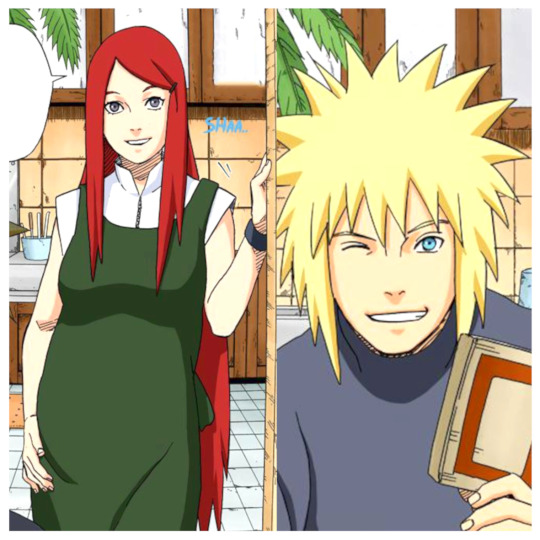
So far we've explored Minato and Kushina's oneness in terms of the Hokageship. But what of their personal hopes and dreams?
(Section B) II. Minato and Kushina as Types
Genin-Kushina speaks of Minato being able to “make all of [her] dreams come true,” and spirit-Kushina thinks, in her final farewell, “our hopes really did reach our son.” On his deathbed, Jiraiya thinks of Naruto as having "inherited Minato and Kushina’s hopes" and makes a direct link between those hopes and the hero of his novel.
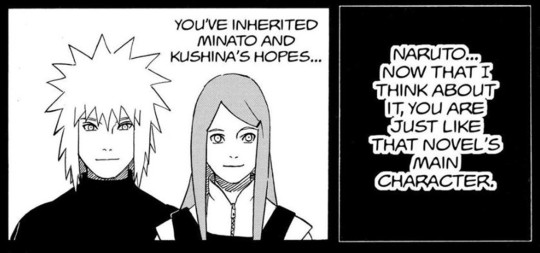
The novel’s hero embarks on a mission to bring peace, and the couple name their son – their future and legacy – after him. Why? Because this “Naruto” embodies their hopes and dream: peace. They grew up in an era of war. Kushina lost her village and is a prisoner and weapon at Konoha’s beck and call. Minato loses two of his students, fails to fix the third's trauma, and sees the woman he loves suffer her entire life being the jinchūriki.

Furthermore, Minato is Jiraiya’s student, whose will he also inherits – harkening to the prophesied shinobi who will usher in an era of peace. A "savior" whom I will call, to maintain the parents' vision in mind, "peacemaker."
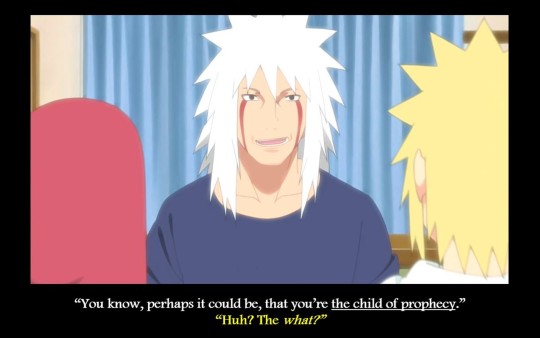
Which, of course, brings us to Minato and Kushina’s living legacy.
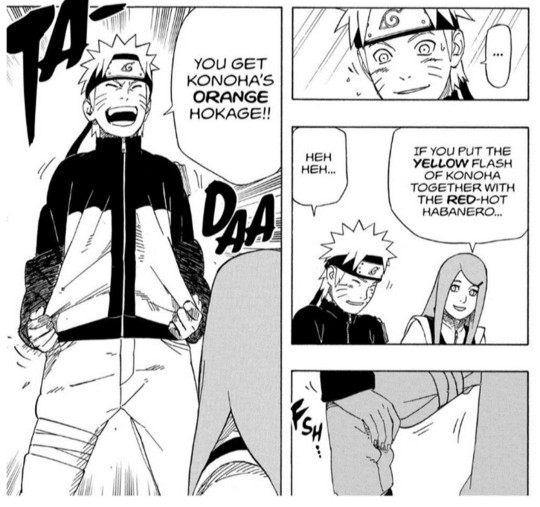
Naruto, this “child of prophecy,” dubs himself “Konoha’s Orange Hokage” as an amalgamation of the Yellow Flash and Red-Hot Habanero. By extension, thus, the peacemaker title belongs to Minato and Kushina together, embodied in the living, breathing, walking result of their love.
We touched on Naruto inheriting his parents’ love and redeeming Kurama (turning Hatred himself into a vessel of love). But moreover, as Kurama’s jinchūriki he is the 'key' to changing the future. Passed from Jiraiya to Minato to Naruto is the mission of bringing peace. And passed from Kushina to Naruto is the means of accomplishing it.

Jiraiya first believes Minato is the child of prophecy (chapter: Minato’s Dead Demon Consuming Seal), and the anime version of their talk features a pregnant Kushina with them. So right as Minato learns of the prophecy, their child – its fulfiller – is present. Foreshadowed is the legacy Minato will bestow both as a peacemaker and the peacemaker’s father.

[On the topic of 'savior,' Naruto has been called by many fans a ‘Christ figure.’ This trope is actually a misnomer. Do you know what Jesus Christ actually did, what salvation actually is? Check out this 1-minute video:
youtube
To define the saviorship motif in Naruto, we're talking about something very different. The series themes salvation as a ‘saving’ from hatred internal and external; a reconciling peace with oneself and peace between nations.]
Jiraiya and Minato’s conversation is not the first foreshadowing of the savior theme. The entire series kicks off, in fact, with the following prologue:

Minato is introduced as Konoha’s “champion” in direct conjunction with “Fourth Hokage.” Then we jump to the title of Chapter 1: Uzumaki Naruto! Naruto debuts desecrating the Hokage rock faces – a jokey hint that he’ll one day surpass them all.
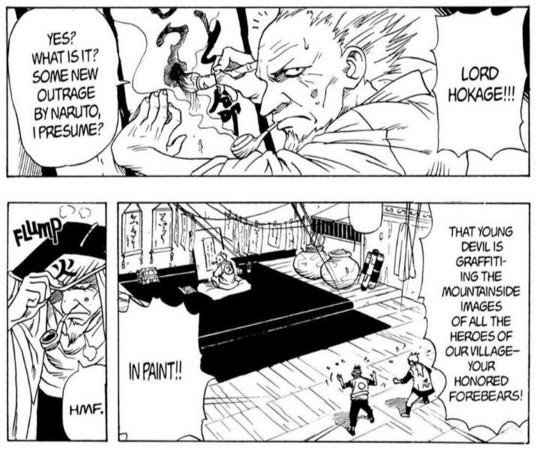
Pranking which, for a fun fact, is an "interest" of Kushina's per one of the databooks.
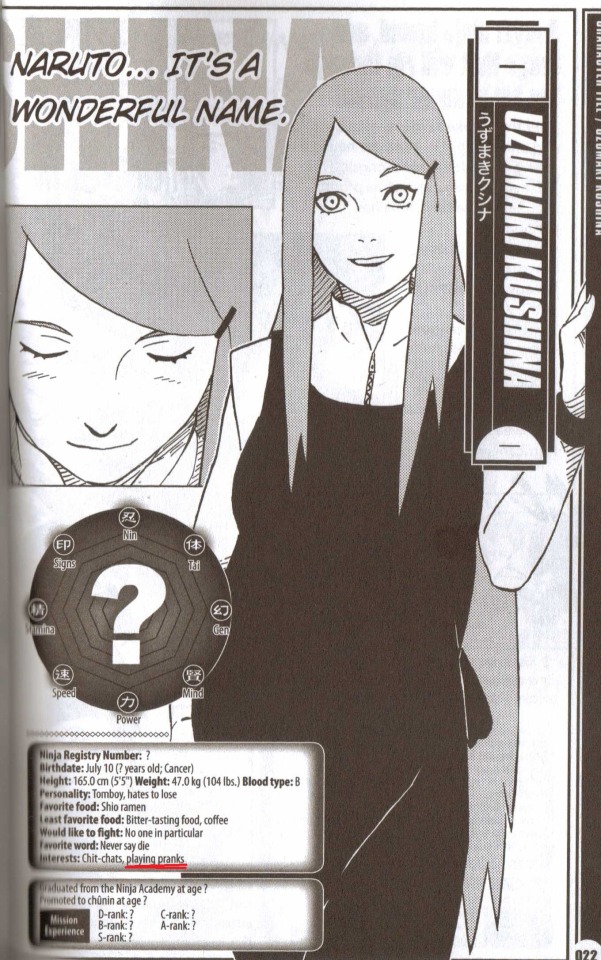
We find mentions of “Fourth Hokage” throughout the story and learn that Naruto reminds Jiraiya of this renowned hero. He appears in person in the prelude to the timeskip – the ‘second prologue’ if you will – as Obito’s sensei. Then we jump to a 15-year-old Naruto returning to the village with Jiraiya. The parallelism in the two ‘prologues’ juxtaposes Minato and Naruto in the grand narrative: Minato is the typological peacemaker who secures the future; Naruto is the legacy peacemaker who carries it out. Minato is both a peacemaker himself and a ‘type’ (a ‘pre-figure’) of the one to come.
How is Minato a peacemaker himself and a type? His love gave Kushina the peace to overcome Kurama, prefiguring the internal peace Naruto will help others achieve. And his actions contributed to ending the Third Great War, prefiguring the external peace Naruto will usher with the Fourth.

Framing Jiraiya’s flashback of Naruto’s parents is the theme of the child of prophecy, in the contrasts between his three students who were candidates for the role. Jiraiya is killed by Nagato who lost faith and betrayed his teachings; he remembers Minato who held faith and died in that faith; and in remembering Minato’s faith he recalls his own faith in Naruto – that Naruto is the one who will see their mission through.
In this flashback Minato is visually removed from “Fourth Hokage:” he is in his plain attire without the cloak. He is verbally removed from Fourth Hokage, with not a mention relating to the title. And we know that he is Hokage because Kushina is (heavily) pregnant.
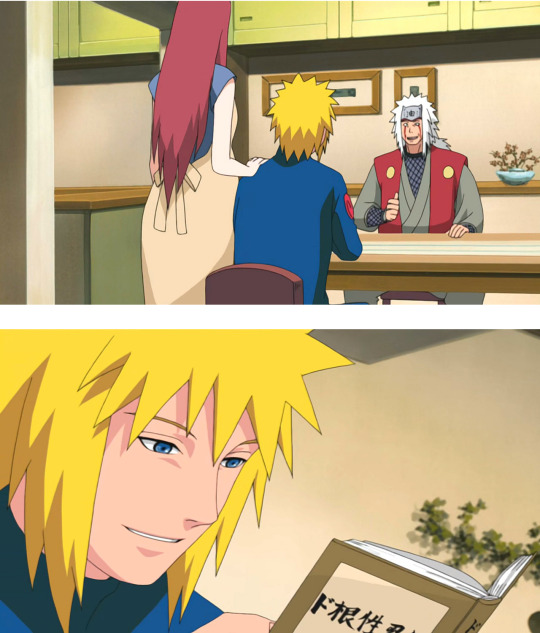
Minato in this scene is three things, linked in the connection of three wills. He is the student of author and sensei Jiraiya, whose will he has inherited. He is the husband of (heavily) pregnant Kushina, who shares (and carries the fulfiller of) that will. And he is the father of to-be-born Naruto, who will fulfil that will.
Moreover, this scene is entirely centered around them naming Naruto (the act of doing so in itself a symbol of passing on legacy). With their child being named after the hero in Jiraiya’s novel, we see the amalgamating of the to-be-parents’ and Jiraiya’s legacies into one.

Kushina likewise is met not as “Konoha’s jinchūriki” but Naruto’s mother – this moment being her first in-person appearance in the series. She is very heavily pregnant, Minato remarking on their “soon-to-born child,” and when she enters the room all attention is drawn to her belly swollen with Naruto.

In both the anime and game versions, in fact, we see Kushina’s belly before we see the rest of her. In the anime, she waddles tummy-first into the frame, and after close-up shots of her and Jiraiya is a close-up of her caressing it. In the game (Storm Generations), we have a mid-shot of just her belly, from which the camera pans up to her face.
[Kushina rubbing her belly could also imply that the baby is kicking, which would further make Naruto not just the topic of, but active in the scene. (Though of course, pregnant women often rub their bellies. Just a thought.)]
Kushina’s mention-debut too is in direct conjunction with Naruto: Tsunade says Naruto takes after “his mother” before she introduces her name. The first word Kushina herself speaks is “Naruto,” with her remark that the name is “wonderful.” And she does the same in her second appearance 16 years later when she saves him from Kurama.
Further, Kushina's mention-debut draws a contrast between her and Minato in relation to their son. Where we’ve been led up to this point to believe that Naruto is a ‘mini-Minato’ (reminding Jiraiya of “Lord Fourth,” having the Hokage dream and so forth), Jiraiya and Tsunade reveal the key twist: Naruto is LESS like Minato and VERY MUCH like Kushina.
Tsunade attributes Naruto’s personality and ninjutsu style to “definitely” being from Kushina. Additionally, aside from his hair and eye-color, his face is the splitting image of his mother’s. (We are in no way discrediting Minato here – Naruto is in many ways, as we’ll discuss, like his father too. The emphasis is that he is far less like Minato in comparison.)
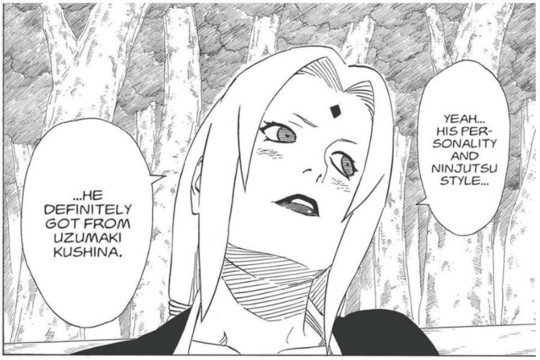
[It is greatly fitting that Jiraiya and Tsunade are the ones to exposit these details, being the prior generation characters themselves in the circle of legacy. As Mito’s granddaughter, Tsunade is essentially ‘the Uzumaki’ of her generation. She also sits in a curious position in the Hokage line: succeeding Hiruzen who (preceded and) succeeded Minato; and preceding Kakashi who will precede Naruto (i.e. one Hokage seat from each). Further, in dynamics and traits we have a multi-generation parallel: Hashirama and Mito; Jiraiya and Tsunade; Minato and Kushina; Naruto and Sakura; and Boruto and Sarada/Himawari. This is something we will visit later too, for there is a plethora of parallels here. (Note I said “dynamics and traits,” not “ships,” so hold your pitchforks. We'll certainly discuss Hinata too.)]
So Tsunade, our Uzumaki ‘cousin,’ tells us that Naruto is most like his mother, with Jiraiya’s agreement and reveal that he does not in fact possess Minato’s genius. (Contrary to a common fan misperception, Naruto is a people and battle genius. So by this lack we mean academic, Kushina herself admitting she was bad at studying.) These statements follow Jiraiya and Tsunade discussing their faith in Naruto becoming Hokage. And here we have in subtext something which gets very much overlooked.
Recall me saying that Kushina gives Naruto the means of bringing peace while Minato (and Jiraiya) pass on the mission. That means is not only Kurama, but the very trait at the core of Naruto’s personality.
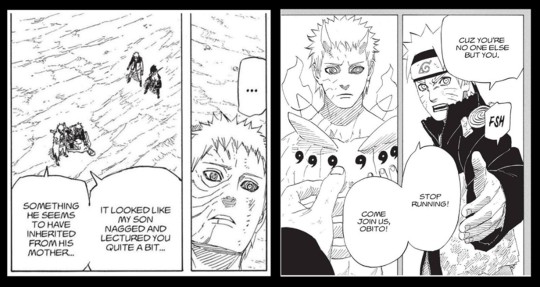
Yes, we are talking about his signature technique: the soul-piercing ‘talk no jutsu.’
It is of no insignificance that Minato’s dying words to Naruto are “ditto your loquacious mother” (or in the anime, "your talkative mom said it all"). Nor that Naruto repeats his mother’s speech to Minato verbatim after he has helped save the world. Minato’s dying act is to sacrifice himself, putting his faith in his son WITH Kushina's chakra. His final departure to the Pure Lands is a following of that faith fulfilled.

It is also of no insignificance that Kushina’s self-introduction to Naruto is on his inheriting her talkativeness. Naruto realizes who she is not by her near-identical face, nor by the fact that he had met his father under similar circumstances, but by her verbal tick 'ttebane like his 'ttebayo. Ironically, her “Minato didn’t say anything?” line alludes to this even further: Kushina is the one to pass on the passionate, empathetic talkative quirk; one Minato doesn't have.
(Let us not distort the context: Minato had far less time with Naruto so he couldn't say much. But the emphasis still stands, for he ensured Kushina would have far more time, saying, “There are things that only you can tell him. Things that I can’t. That’s a mother’s role.”)

Further, Kushina's starkest display of this quirk is while she is pregnant with Naruto. Recalling his promise to her, Edo-Minato thinks back to her rambling about the future traits of their baby. And when he calms her, asking how she could possibly know, she replies with confidence, “Because I’m his mother.” Look at the manner in which she says it here below: her expression reads, "Well, duh." She is fully convinced that their baby is a boy and that he will want to be Hokage, that he will act up when his father is busy and be a little trouble-maker.

And she works herself into a state over it, showing her intuition and empathy. She envisions Naruto acting out to get attention when feeling deprived due to Minato's work. She envisions how this will further affect his behavior, leading him to "defy his teachers" and so on. What we see is a display of how deeply she can read others on circumstance, and what is played in the fretting-mom sense gets passed to the child in her womb. The intuition and empathy by which this baby will peer into people's hearts and expose their desires and philosophies, expressed through his talk-no-jutsu.


Why is this so crucial? Because Kushina is a ‘type’ for the “child of prophecy” too. Naruto is Minato’s legacy as rescuer; he is Kushina’s as redeemer. Two aspects wholly intertwined in him achieving their dream of peace.
And on that note, we can now delve further into internal conflicts – beginning with Minato journeying on his personal redemption arc.
Section B, Part III here.
#naruto#naruto shippuden#naruto gaiden#the whorl within the spiral#boruto#manga#anime#namikaze minato#minato namikaze#minato#uzumaki kushina#kushina uzumaki#kushina#uzumaki naruto#naruto uzumaki#jiraiya#tsunade#senju tsunade#tsunade senju#hokage#my deep dives#character analysis#kurama#minato x kushina#minakushi
45 notes
·
View notes
Text
Minato & Kushina: A "Deep Dive" Analysis (Section B, Part I)
In our first section we explored Minato and Kushina's love and endurance. In this section we will consider their dream of Hokage and impact on the wider plot.

(Section B) Minato and Kushina as drivers in the world narrative
Note that I said their dream of Hokage, not Minato’s dream of Hokage. Not because they both want to become Hokage, but because, as we established, Hokage is intertwined with their marriage.

(B) I. Minato and Kushina as the image of Hokageship
Chronologically, the first words uttered by both Minato and Kushina concern becoming Hokage. But while similar on the surface, their utterances spring from contrasting motives.


Minato wants to be respected by the village. Kushina wants to not be snubbed. Each is seeking to be acknowledged, but a different form of acknowledgement.
Minato is a once-in-a-generation genius. He will graduate the Academy at 10. He will set the record for the highest ever score on the chūnin written exam. He will be honing the Flying Raijin by the time he is 15-16, by which time Kurama will think of him in respect to the greatest shinobi who ever lived. From this, one can sum that Minato is destined to become Hokage. Yet at the same time, paradoxically, his birth sets him apart.
The non-mention of other Namikazes implies that he is not from a ninja family – or, that he is from a ninja family with no reputation. Either way, Minato is a genius born in an underdog background, and thus has the complete freedom to pursue the Hokage path. And that path he himself has chosen out of desire to be the leader and light of Konoha, his favorite phrase per the databook being 火の影は里を照らす (“the fire’s shadow illuminates the village”).
What is Minato’s sought “respect” then? To be relied upon as THE shinobi who illuminates the village. For Kushina this is not the case. She simply wants to be SOMEbody.

[As we noted last section, with her motive in these screens, Kushina is never, ever shown pursuing Hokageship. So let us bury all distortions of her as a 'girl boss' who 'had her dream stolen by' the man she loves. And let us bury the demeaning of Minato along with it as some 'male wife' who 'fulfilled his girl's dream because she couldn't.' To the fans who insist that Kushina's character was diminished through Minato becoming Hokage, I leave one question: is it a shame and disgrace for a wife to uplift and support her husband?]
Brought to Konoha from a foreign land, Kushina just wants to fit in. But opposite to prodigy-from-nobody-clan Minato, her bloodline has her shackled to a destiny of rejection.
Which brings us to another thing that Kushina’s hair symbolizes: her ‘otherness.’ We’ve seen this motif with other characters before. Sakura is teased for her big forehead and Hinata is called “Byakugan Monster” for her eyes. Sakura’s source of misery becomes her source of prowess: she hones the Byakugo Seal on that forehead, and it becomes her trump card through which she saves hundreds during the War. Bullied for her “weird, freaky eyes,” Hinata likewise improves her use of the Byakugan, eventually proving her worth as the Hyūga heiress.
Kushina is teased when really, as we’ve observed, her “ugly” “lustrous” hair implicates beauty and strength. But in contrast to Sakura and Hinata, Kushina stands up to her bullies in her own strength (Sakura gains confidence through Ino’s compassion, and Hinata from Naruto). And this contrast is immensely important for, as we’ve established, Kushina’s endurance is the core of Minato’s drive.

Kushina’s endurance, recall, is the reason Minato fell in love with her, and why he calls her the one “that made [him] the Fourth Hokage” (as we'll examine shortly). And Minato’s love is the thing that enables Kushina to overcome fate; to live a life of happiness despite being a jinchūriki. For while Kushina’s endurance draws Minato toward her, it results in her being further set apart as the 'other.' She defends herself; Minato reveres her more; their peers despise her more. The divide between Kushina and their generation grows, held in the title they give her: “Red-hot Habanero.”

She cannot escape her destiny of loneliness. She is doomed for being the jinchūriki; doomed for being a red-haired Uzumaki; and doomed for kicking back through her own efforts. Yet her efforts draw Minato to her, setting Minato apart from their peers in parallel.


What is the importance of this parallel divide? We will get to that shortly. But first there some details to note on Minato's otherness (his distinction from their peers).
Minato as the ���Yellow Flash” is directly tied to a Hokage (it is his use and adaptation of Tobirama’s Flying Raijin that earns him fame and fear). Put short, Minato’s earning of Konoha’s respect is already bound to Hokageship: he is, in will, genius and prowess, walking in his forerunners’ footsteps.


Furtherly significant is Kurama’s comparing of Minato to Hashirama. Gaiden opens with Minato escaping Bijū Bombs with the Raijin – a homage to Tobirama. It ends with Minato smiling in front of the rock faces where his own will be beside Hiruzen’s. And framed within these scenes is Kurama’s remark grouping him with Hokage ("A most powerful shinobi ranking alongside First Hokage Hashirama... Unbelievable!").

The Yellow Flash rapidly gains renown in the other nations – to the point of him earning a ‘flee-on-site’ reputation. Feats so formidable that the Tsuchikage accepts a peace treaty, bringing an end to the war with Iwa (episode: The Mask that Hides the Heart).

So Minato in legacy of Second Hokage earns respect within and outside Konoha. And “in his own style” he earns “a most powerful shinobi ranking alongside [First Hokage].” In the Fourth War, the resurrected Tobirama will acknowledge Minato as having surpassed him. Furthermore, Minato modifies his jutsu to create new subsidiary jutsu.

Minato has been, through his whole ninja career, gaining the repute to achieve Hokageship.

Academy-Minato begins walking this road. Hokage-Minato ends the road by accrediting it all to Kushina. Recall our panels back in post one from the chapter Thank You:

There is a slight variation in the anime’s account from “your” man to “a” man (for Japanese has no indirect articles and omits pronouns in conversation). In addition, anime-Minato makes this statement over an image we’ve seen before: his genin-self holding genin-Kushina in his arms the day he'd rescued her. This shot, in addition to the dialogue, is framed from Minato’s viewpoint, inferring that he sees this event and resulting bond with Kushina as the statement’s fruition.
The day Kushina fell for him, in other words – the day (from which) she became his woman – was the very day (from which) she in Minato's own view “made him a man.” What transpired up to that moment? He had been watching her endure. And now he has stepped in to be her strength in a battle that is beyond her.

The differing English translations both capture the essence of Minato’s words. He could not have become Hokage without Kushina – without her ‘making him a man’ who self-sacrificially loves, leads, protects and provides. And he could not have become Hokage without her ‘making him her man’ – without her deciding to be his wife; to selflessly love, support and build him up, bringing out his best. Furthermore, birthing their child, Kushina makes Minato a father. Mirroring this as Hokage, he is the patriarch of the village.

Now onto the importance of the 'otherness' divide: Kushina symbolically ‘qualifies’ Minato to become Hokage through their distinctions from their peers. And these qualifications are reached through two ‘tests,’ if you will, which each center around him saving her.
The first test is our mentioned genin rescue, where Kushina embodies the outsider. Here she is the lowest-esteemed villager, the foreigner shunned by the village. Minato alone notices the trail of her hair she left behind and saves her. Minato alone tells her that she is “one of [them].” He proves that he is devoted to protecting EVERYONE in his village, in a conflict between Konoha and Kumo – a fight between villages.

Most importantly of all, it is in this moment that he wins Kushina’s acknowledgement. The acknowledgement of the hardest-to-win-over villager, the acknowledgement of the outskirt 'other.'

The second test is the teenage rescue, where Kushina is the jinchūriki. Here she represents Konoha’s balance of power in the world. If a village loses its bijū it is vulnerable to destruction by the other nations. Protecting Kushina thus means – in the village context – everything, and is the ultimate test of Minato’s physical, mental and intellectual worthiness. Simply put, all together, it is a test of his own endurance.


Rescue One is the test of acknowledgement, and Rescue Two is the test of endurance. The two qualities underpinning the entirety of one's enablement to become Hokage.


So what have we then? While Minato brings Kushina to breaking the shackles of her destiny, Kushina brings Minato to fulfilling his destiny.
We also see the monumental impact of Kushina’s sealing jutsu. On the night of their deaths, Minato uses two to save the village: the Eight Sign Seal and the Reaper Death Seal. Both of these techniques are Uzumaki clan jutsu taught to Minato by Kushina.

In other words, Kushina indirectly gives Minato the means of saving the village.
[The Reaper Death Seal was designed by Uzumaki to be used by Uzumaki. The caster sacrifices his or her chakra to the Reaper in proportion to the chakra being sealed. If cast by an Uzumaki then – with chakra reserves exceeding an enemy's – that Uzumaki need not die. That Minato sealed half of Kurama away at the cost of his life is a testament to just how much of a powerhouse he is!]
The Reaper Death Seal has even further ties to Hokageship – Hiruzen using it to seal his Edo-forerunners during the Konoha Crush arc. Though it was taught by Kushina, it is known as one of Minato’s signature jutsu, Hiruzen calls it his own “trump jutsu,” and it – literally – unites the first four Hokage in death (the spirits of each, after Hiruzen’s sealing, being trapped in the Reaper’s belly).



So we've examined ‘Hokage’ in relation to Minato and Kushina's oneness. The next post will explore their dream behind the Hokage image.
Section B, Part II here.
#naruto#naruto shippuden#naruto gaiden#boruto#manga#anime#namikaze minato#minato namikaze#minato#uzumaki kushina#kushina uzumaki#kushina#minato x kushina#minakushi#uzumaki naruto#naruto uzumaki#senju hashirama#hashirama senju#hashirama#senju tobirama#tobirama senju#tobirama#sarutobi hiruzen#hiruzen sarutobi#hiruzen#hokage#my deep dives#character analysis#kurama
110 notes
·
View notes
Note
Hi! I just wanted to say that I love your MinaKushi deep dives! They’re my favorite couple in Naruto and I love delving deeper in their stories.
And you’re really brilliant for doing this! 💕 Hope you have a nice day!
Aw, thank you, kind friend, I appreciate your message. Glad you're enjoying them! Do inform me if I ever stray off track though haha. Next section will be up this month. Have a great day too!
#minakushi#minato x kushina#minato namikaze#namikaze minato#uzumaki kushina#kushina uzumaki#minato#kushina#character analysis#my deep dives#naruto gaiden#naruto#manga#anime
8 notes
·
View notes
Text
Minato & Kushina: A "Deep Dive" Analysis (Section A, Part III)
Today we will conclude Section A on Minato and Kushina as each other's anchors. (See Parts I and II here.)
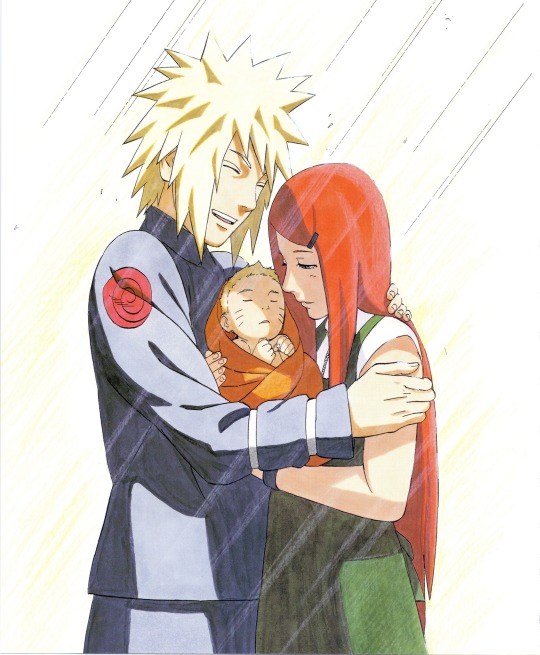
Picking up where we left off in Gaiden, we have Kushina’s coming-to…
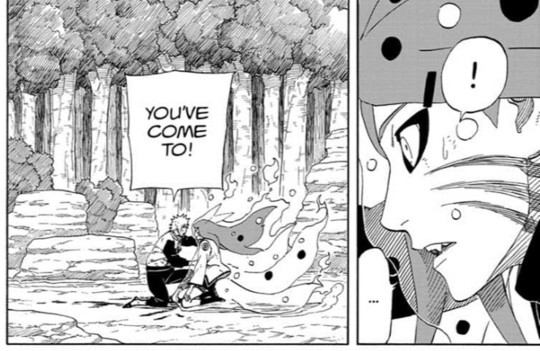
…and the climaxing showdown with Kurama.
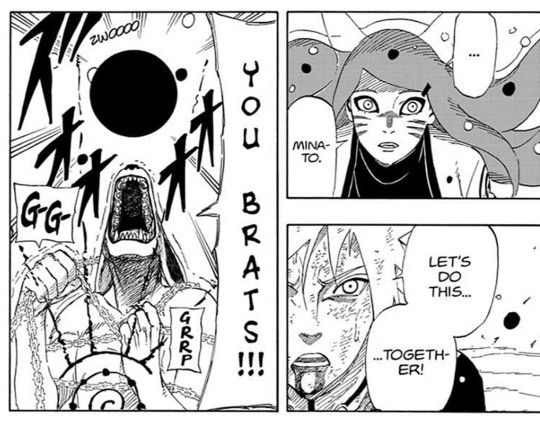
(Section A) III. Minato and Kushina as unified anchors
Now it must be emphasized that, as the manga has shown all along, Minato and Kushina rival Kurama together. There is no ‘Minato fights Kurama’ or ‘Minato wins ‘with Kushina’s help,’ as many fans have misread. The two are a duo, a uniform team; two equal halves of ONE. And ONLY against these two equal halves of one TOGETHER is Kurama overcome. That is how it is here. That is how it is the night they save the village. And that is how it is with Kurama’s redemption (the child born of their love, half-Minato-half-Kushina, fulfilling their legacy).
To make this abundantly clear, Kishimoto filled the oneshot with notes to Kushina’s prowess. So let us consider the showdown within its proper context.
The chapter opens with Iwa’s two jinchūriki saying to an outmatched Team Jiraiya, “If you really wanna fight us you better bring Nine Tails’ jinchūriki.” Their use of Bijū Bombs tells us they would be rivaled by Kurama’s power. And it tells us Minato is no match for Son and Kokuō’s, who, put together (as we learn in the main manga), are weaker than Kurama. Thus Minato by himself, let alone with his Sannin sensei, cannot match two Bombs weaker than one from Kurama. “...you better bring Nine Tails’ jinchūriki.” The very opening line foreshadows Minato and Kushina fighting together.
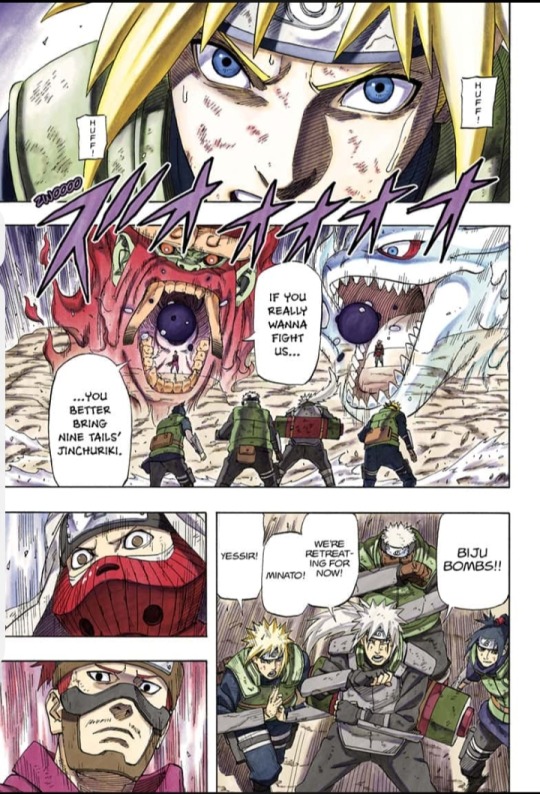
A few pages later, Kushina meets her keepers, saying she has “sealing jutsu training with Namikaze Minato.” The next page reveals that she is teaching Minato Uzumaki fūinjutsu. When Minato augments her seal in his own style against Kurama, thus, he is enhancing a jutsu that he learned from Kushina.
“I promise to go all out again today!”
Kushina has been giving these lessons her all and Minato has more than kept up.
“You pick up things real quick, Minato. And there are still tons of Uzumaki clan sealing jutsu WE haven’t covered yet, so...”
They have been doing this together for more than a while.

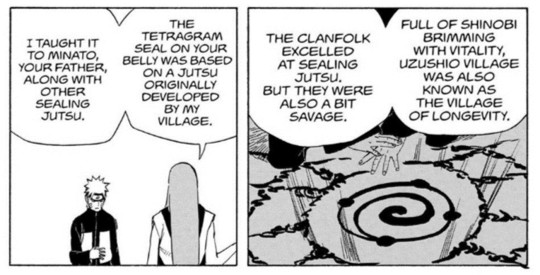
Skipping forward (in flashback), Mito remarks that Kushina has “much more lustrous hair” (strength) than her – i.e. Kushina will surpass the woman who sealed the full Nine Tails inside of herself. We have seen a 24-year-old Kushina give birth, have Kurama extracted, subdue him while at death’s door, and offer to fully seal him back and drag him with her into death all within the same hour. At death’s door. Are we for a moment to assume she didn’t have even a portion of this power as a teenager? Why is this emphasis of Kushina surpassing Mito important? Because it is a mirror parallel:
Minato has “a most powerful shinobi ranking alongside First Hokage Hashirama;”
Kushina is “a strong child” with “much more lustrous hair than [First Hokage Hashirama’s wife].”
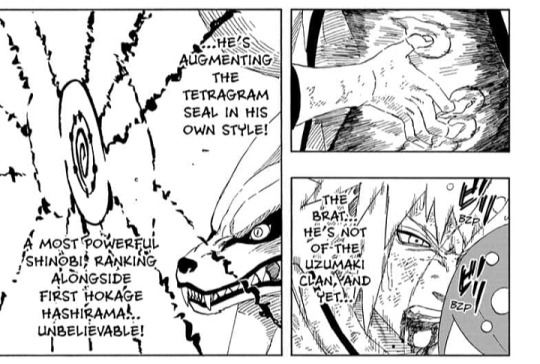
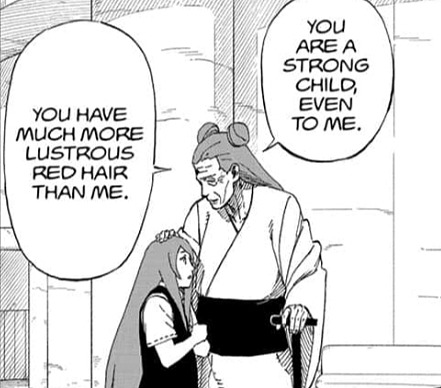
While Minato is creating the Rasengan, Kushina with implied ease binds her ANBU guards (two of the top jōnin in the village) with both unable to break free. One thinks to himself how her binding power is getting stronger with age – implying that it may not be the first time she has done this.
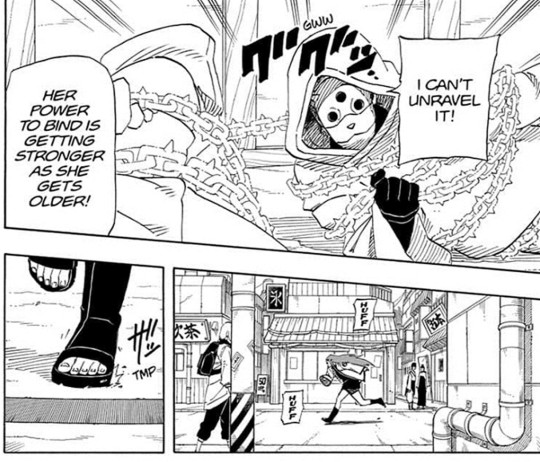
The jutsu common to dying-Kushina's last stand, the ANBU-binding, and the fight against Kurama is her Adamantine Sealing Chains. What do these Chains seal? Chakra. What is Nine Tails? A breathing mass of chakra. Where is she currently sealing him? Inside the seal binding him inside her. He is not at his full fighting capacity.
So we are inside Kushina’s seal by which Kurama is already bound. He has struck and stabbed Minato (we’ll get to Minato’s nerfing in a moment) and is wrestling Kushina for control – i.e. Minato and Kushina are also not at their full fighting capacity. Kurama is forming a Bijū Bomb in his (breaking) binds while Kushina is further binding him with her Chains. Our weakened Minato uses Rasengan against Kurama’s weakened Bijū Bomb and manages to match it enough to fix Kushina’s seal in a double knockout.
Minato is seriously underrated. But let us not forget: so is Kushina. And it is their combined, two-halves-as-one power that defeats Kurama. Just like in their final fight in which they save Konoha.
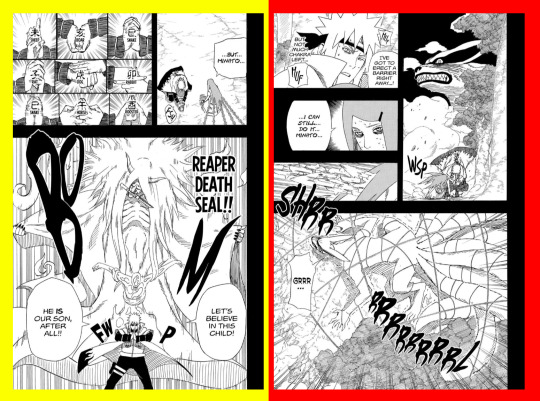
Now onto Minato’s nerfing. Kushina is knocked down and he is stabbed in her seven-tailed bijūfication. Kushina screams for him to leave her and save himself, but he refuses. (If this isn’t a display of utter, unwavering devotion I don’t know what is. With a literal hole through his stomach, Minato tells her that he will never leave her.)
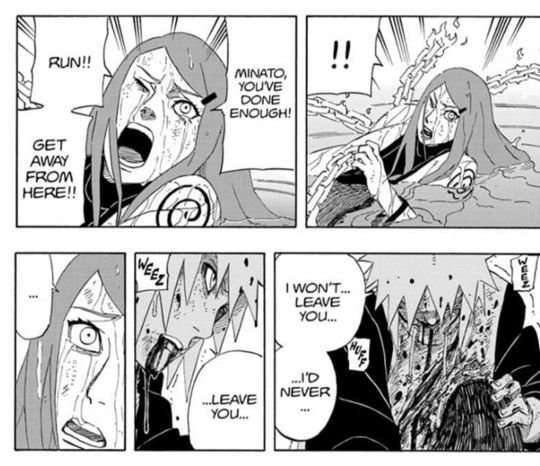
But let us backtrack even further. First, Minato has been training all day. Since he returned from the battlefield. Creating his A-rank jutsu. The training grounds are covered in craters he made, and he promised Jiraiya he would rest. This is no run-of-the-mill practice session. He is exhausted. (Similar, to note, as he is the night of Naruto’s birth. He – excruciatingly – keeps Kushina’s seal together throughout her entire labor.)
Second, the wound Minato has already received – from chakra tail one – was no run-of-the-mill slap. Recall a parallel when Naruto bijūfies and Sakura, trying to call him back, takes a similar hit. It effectively poisons her; Kurama’s chakra seeping through her wound and numbing her body. Even after she heals herself with medical ninjutsu and is later healing Naruto.
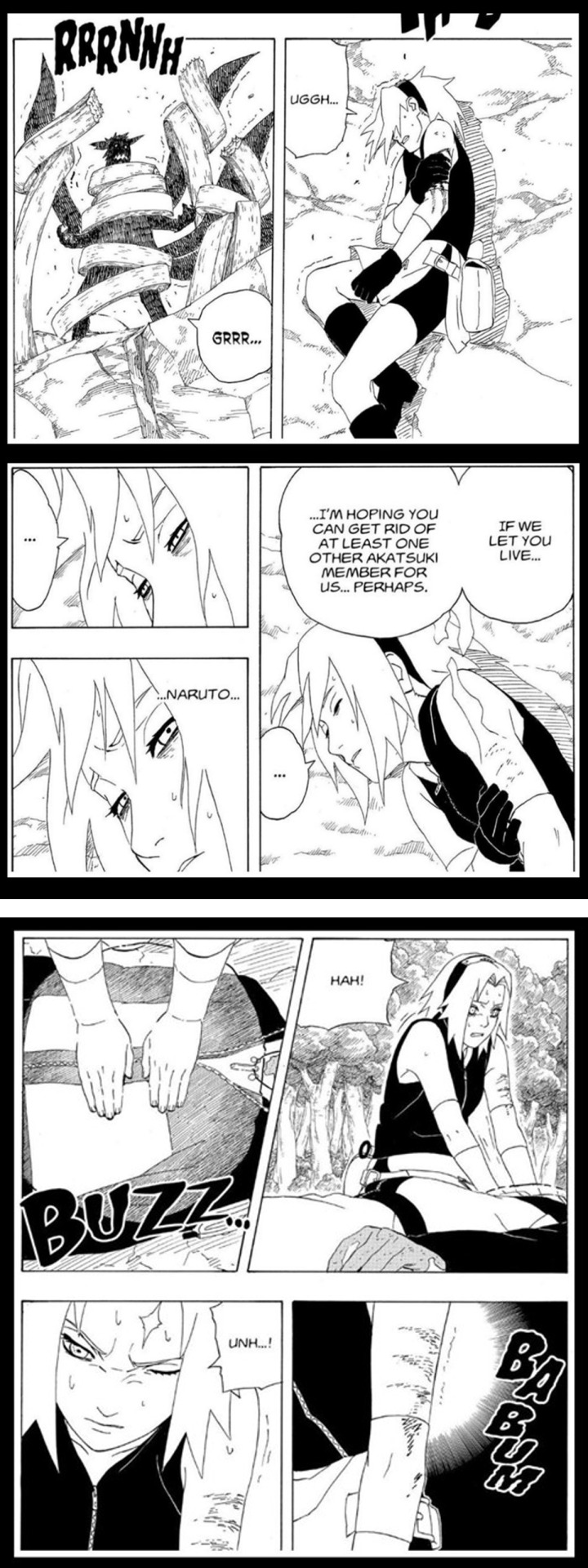
Sakura was struck by a manifesting half-Kurama. But Kushina, unlike her son, had the full Kurama inside her. Take the damage that Sakura – the Hokage’s apprentice and a medic-nin more adept than anyone in the whole Sand Village – took, and double it. That is Minato’s blow.
Poisoned (essentially) and stabbed (foreshadowing his future death), our man is facing losing odds. On top of having worked on his jutsu all day, expending a considerable amount of chakra. Yet in his endurance FOR Kushina (inspired BY Kushina's endurance as we noted in Part I) he realizes a way through. What a man. And thus, we have the climaxing resolution of the vessel motif: Kurama proclaims Kushina as his “pillar” – that, in effect, he has filled her vessel. Minato, sensing his own love inside her, tells him that he is wrong.
Feeling their mutual love for one another is what enables Minato and Kushina to push through: here at last Kushina realizes her vessel full, and Minato, feeling her feelings, projects himself into the seal. This mutual love can also be viewed in terms of being a seal itself. Note Minato's language, present tense: “I exist inside Kushina at all times!!”
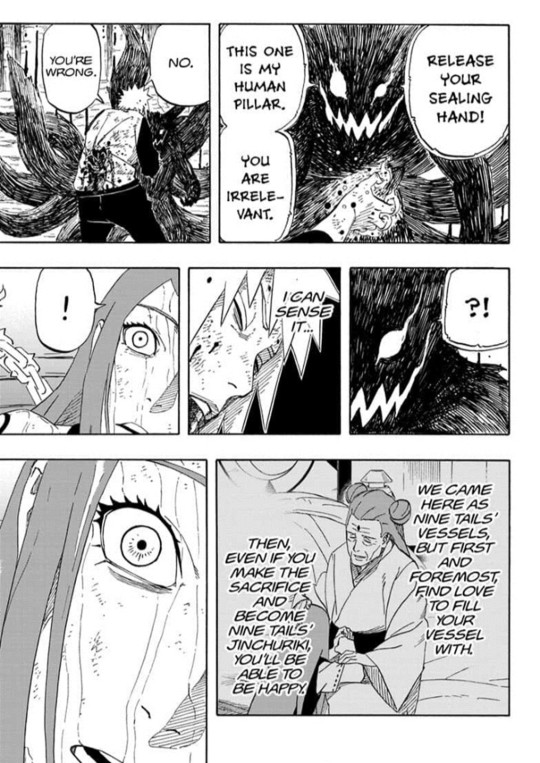
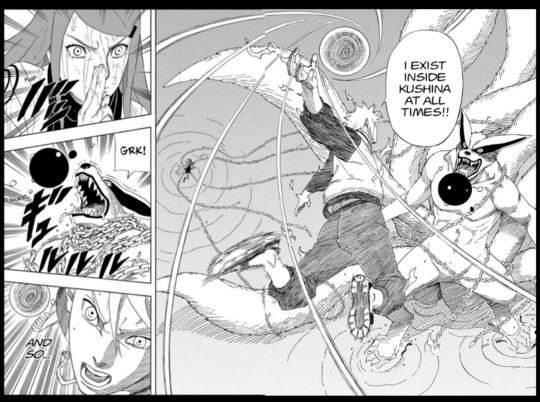
Finally, persisting in their love and endurance, they muster the mental and physical power to together defeat Kurama.
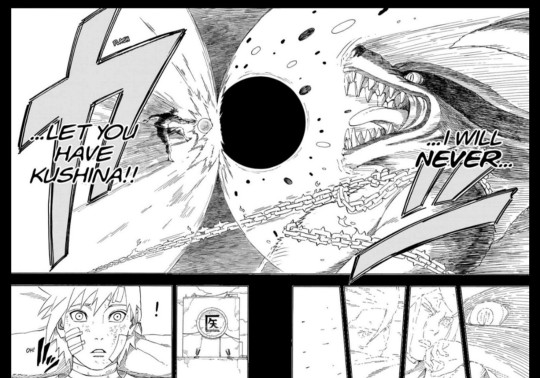
Recall that this mirrors Naruto’s overcoming – again right to the angle – where Kushina also uses her Chains and Naruto his father's jutsu. Put together thus, our moment in Gaiden foreshadows Hatred's defeat, where Kurama's arc will shift from vengeful monster to redeemed friend of Konoha. Moreover, it foreshadows the climax of Minato and Kushina’s arcs: their legacy as fulfilled in Naruto, for both Naruto and the village.
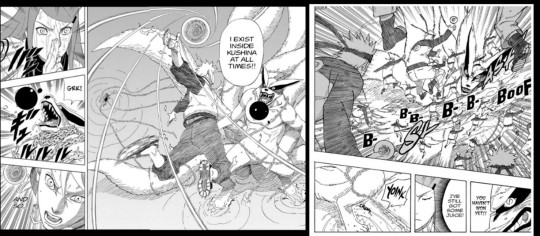
So in summary so far, Kushina is Minato’s anchor and Minato is Kushina’s. Each sees the other as the stronger one, while simultaneously strengthening the other. They change each other for the better and endure, embodying what ‘Hokage’ stands for. Which brings us to our next section concerning the wider narrative: their dream of Hokage.
Section B, Part I here.
#naruto#naruto shippuden#naruto gaiden#the whorl within the spiral#boruto#manga#anime#namikaze minato#minato namikaze#minato#uzumaki kushina#kushina uzumaki#kushina#kurama#uzumaki naruto#naruto uzumaki#character analysis#my deep dives#minato x kushina#minakushi
45 notes
·
View notes
Text
Minato & Kushina: A "Deep Dive" Analysis (Section A, Part II)
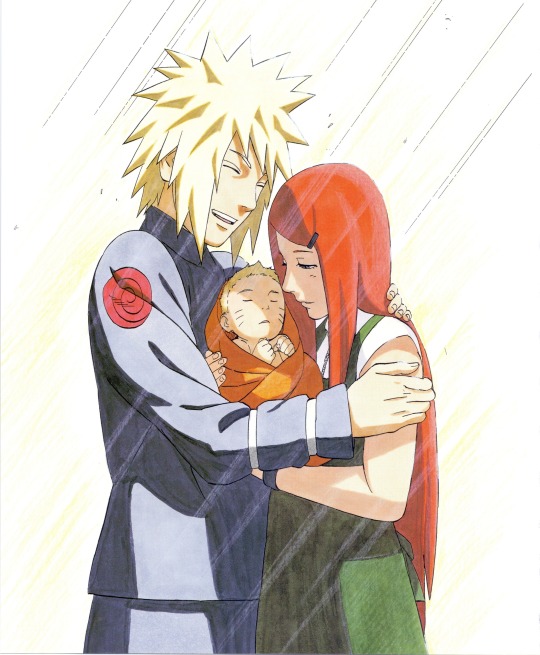
Last post we examined Kushina as Minato's rock. Today we will examine Minato as Kushina's.

(Section A) II. Minato as Kushina's anchor
To bridge into this, I want to linger on the hair-strength metaphor we established just a bit longer. For even before Kurama enters the picture we had a foreshadowing of love vs. hate. Both ends are symbolized in this same metaphor: because it was a source of her shunning, Kushina hated her hair; until it “brought” her Minato, where she began to like it.
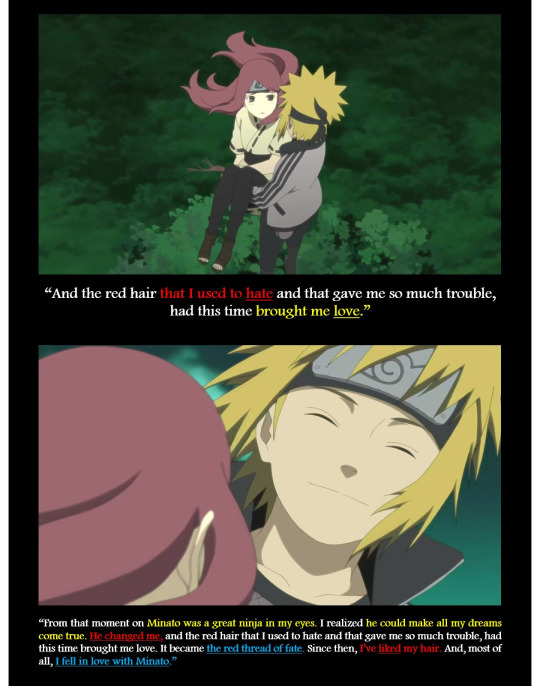
[The red thread of fate is a real-world East Asian myth. An invisible red cord is tied around the finger of a boy and girl ‘destined’ to meet, fall in love and marry. The cord may stretch, pull, twist and tangle, but it never breaks. Interestingly, from the moment Minato saves her, Kushina never seems to cut her hair…]
Now on a thematic note, I've color-coded key aspects of their relationship blue (like the Rasengan in the anime, which we'll discuss later), for orange will be for Naruto.
When rescuing her from the Cloud captors, Minato wins Kushina’s reverence and faith. Reverence for his skills as a ninja, and even more so for his devotion to all the village: he came to save her, the outsider, calling her “one of us.” In this rescue, he gains her dual-way faith that: 1) that he would one day become Hokage; and 2) that he could “make all of [her] dreams come true.”
This dual-way faith entwines the Hokageship and their marriage long before either happens. In other words, Kushina is wholly devoted to Minato, sharing his dream for the future. How do we know this? She purposefully decided that she’d “be the wife of the Fourth Hokage.”
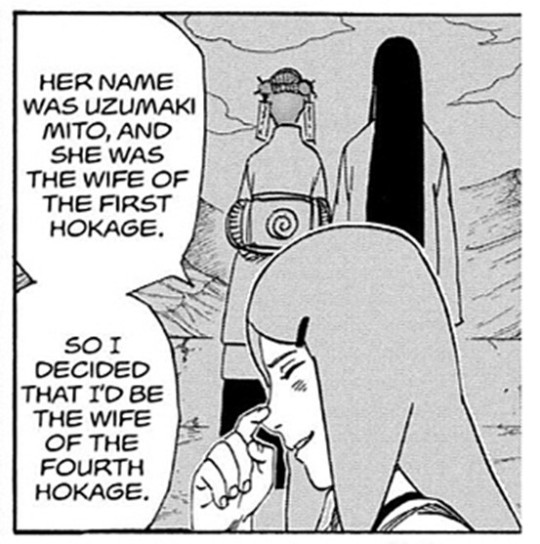
Now there is a misinterpretation plaguing the fanbase that Kushina ‘gave up her own dream of being Hokage so that Minato could fulfil his.’ Friends, this couldn’t be further from the truth. It comes from a complete misreading of her character. Her statement of becoming the “first female Hokage” came from a reason she herself explains, and while it (very much) parallels Naruto’s she is not once shown chasing Hokageship.
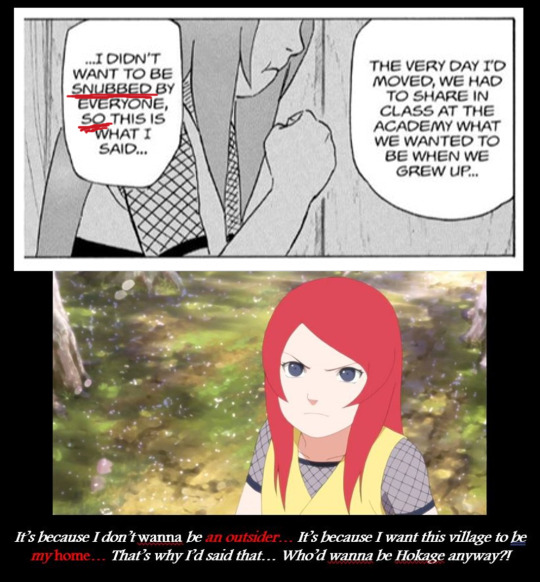
(We will touch on this further in a later post.)
When Kushina realized her decision to “be the wife of the Fourth Hokage” is up to speculation. The Whorl Within the Spiral however – if not precisely – gets us pretty damn close.
Recall first, with the conjunction “so” (chapter: The Birth of Naruto) from our panel two screenshots above, that she names Mito and Hashirama’s marriage as influential. Before Kurama’s transfer, Mito takes Kushina to look at the Hokage rock-faces. They gaze up at Hashirama’s, and Kushina learns he is the love “inside [Mito’s] vessel.”

Which brings us to the ‘vessel’ motif. As Kurama’s jinchūriki, Kushina is a vessel for the embodiment of hatred. To overcome the hatred – that is, Kurama’s essence – and live happily, she must fill her OWN ‘vessel’ with love. This motif is repeated through the same flashback occurring in both the main manga and oneshot, the screen below being from The Birth of Naruto as introduced for the first time:
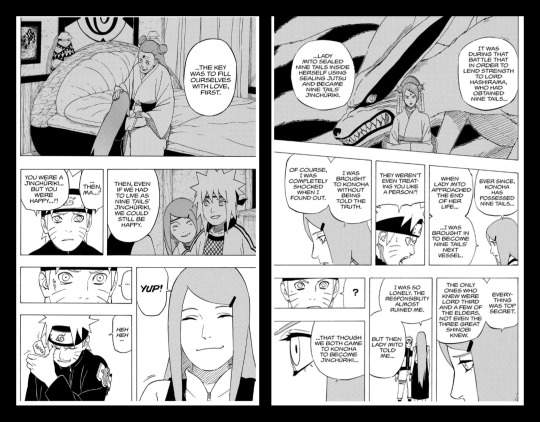
In Gaiden’s ending, Kushina is standing where Mito stood, looking at Minato’s face; Minato being, as Hashirama was for Mito, the love inside her vessel. Minato is angled exactly where his face will one day be carved in the rock. A direct shot from Kushina’s viewpoint, the panel implicates that she resolutely believes he will become the next Hokage, and, now knowing her vessel full with his love, she will one day be his wife.
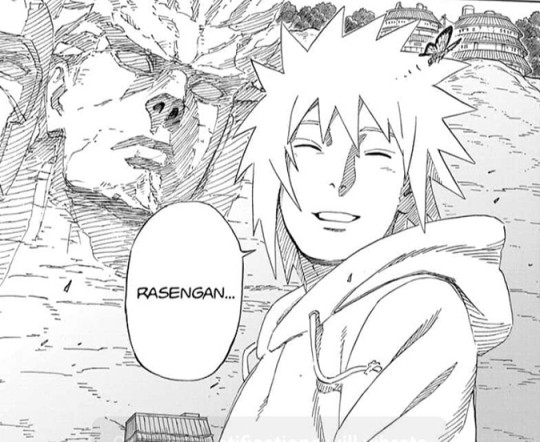
Let us now consider how Minato’s love enables Kushina to overcome.
First, the words that trigger her seal to break, which leads into his confession. The trigger itself, ironically, is an implicit statement of love. (Not simply or specifically romantic love, but one of protective devotion.) Minato tells Kushina about the jutsu he’s been creating (oh we’ll get to this gem later) for her to protect her. He reveals, in other words, that she’s tremendously precious to him and keeping her safe is his top priority.

Do these words sound familiar? To the anime-watcher they should. They’re the exact words Minato told Kushina the day she fell in love with him.
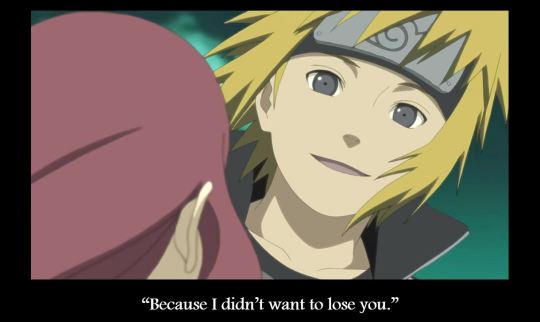
The repetition is telling for it is Kushina’s moment of realization, in the sense of her faith and hope in Minato being proven true (a faith and hope so strong that she crossed the safety of the sealing barrier to go to him, resisting Kurama’s taunts and threats with “But I’ve got... [Minato]”). Not just the realization that Minato cares for her so deeply that he will create an A-class jutsu for her, but the realization that Minato has cared so deeply for her this entire time. His protection, she realizes, is unwavering: it is a protection that endures. And so, in perfect contrast, this realization sits framed between Kurama’s tauntings on trust.
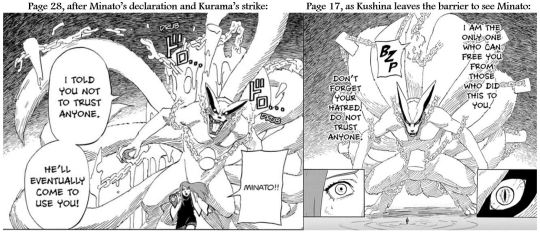
The first time Minato said, “I didn’t want to lose you,” Kushina was the outsider brought into his circle of precious people. Now the context is far more intimate, and Kushina is overwhelmed with what it means. Kurama has been provoking her despair and loneliness day after day. Saying that everybody is out to use her – a reality echoed in Minato’s own words prior (panel below). The village is out to use her – she’s its trump card in war. But Minato is not, putting his every possible effort toward her wellbeing.
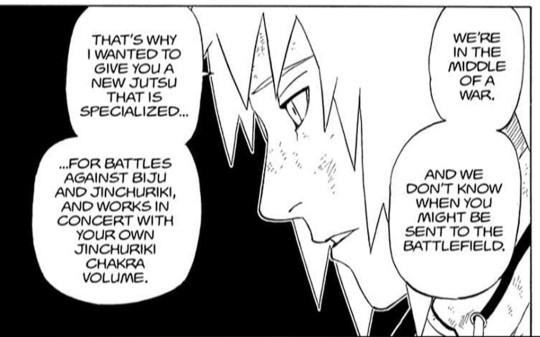
So when Kushina hears this she is overcome with emotion. And with her vulnerable outside the barrier, Kurama takes the opening.
It may be worth mention (though this is me speculating) a parallel with Naruto’s birth. Kushina’s seal weakening is explained in the physical: while she is pregnant, her chakra that would support it is divided and diverted to growing the baby. Childbirth is also specified as the time a jinchūriki’s seal “can come completely undone.” But the exhilaration of becoming a mom playing a role in its breaking strikes a parallel. In both situations, the seal is already weakened: one in her leaving the barrier to see Minato; the other for Naruto’s nourishment. Both weakenings are in themselves driven by Kushina’s love: one romantic; the other maternal. In both, Minato strenuously keeps the seal in check, the fight being driven by Minato’s love. And in both, Kurama’s attempted breakout is enabled BECAUSE OF their love: Kushina being emotionally vulnerable due to Minato’s direct declaration; and the literal life-result of their love being ready to leave her womb.
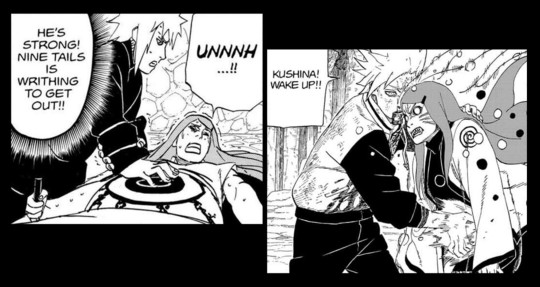
In both situations thus, Minato and Kushina’s love pushes Kurama’s hatred to further retaliate, highlighting a foilism between the couple and Kurama. Just as Kushina and Minato fight his hatred, Kurama fights their love, foreshadowing his eventual redemption through that love passed onto Naruto.

Now back to Gaiden and out of the theory zone. We have a bleeding Minato holding a bijūfying Kushina while augmenting her seal. Which leads to Kurama acknowledging Minato’s skill and strength. Which leads to Kurama asking why Minato would stick with Kushina to the point of risking his life. Which leads to Minato proclaiming with utmost determination that he loves her.

Hearing this, Kushina recalls Mito’s words about filling her vessel, and, realizing her vessel filled, she gains the strength to fight back. Moreover, Minato declares this to Kurama, placing himself in the role of a perfect foil: Minato is the embodiment of love inside Kushina; Kurama the embodiment of hatred.
“Release your sealing hand! This is my human pillar. You are irrelevant.”
“No. You’re wrong.” I can sense it... “I exist inside Kushina at all times!”

And here we are given one of the most striking parallels in the series. Minato’s declaration spurs Kushina to unleash her Chains against Kurama in her seal. The same thing happens – right to the angle – when Kushina appears in Naruto’s seal.

Hugging his mother for the first time, Naruto is overcome with love – under the mirror circumstance of a near-defeat by Kurama. Kushina projects her Chains, her own chakra, through her son, pinning Kurama herself. She then tells Naruto her and Minato’s story, and then, in playful conversation about her hair tells him that she loves him. (The significance, recall, is that of “the red thread of fate” – i.e. the unbreakable thread of love that exists between Kushina and Minato.)
She tells Naruto he is the second man to ever compliment her hair. Following her recount of genin-Minato calling it beautiful, we get this:
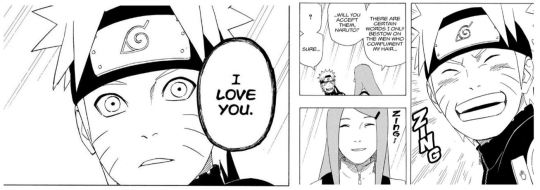
Kushina’s declaration to Naruto being centered around the “red thread of fate” symbolizes her passing to him her and Minato’s love. Upon hearing her words – receiving that love – Naruto gains the strength to defeat Kurama, in precise mirror to Kushina hearing Minato’s confession.
But there’s more. Note the language: “I love you,” “…so happy!!” This is identical to the language Mito employed when telling Kushina to fill her vessel.

And to top it off we have the vessel motif explicitly repeated. The Japanese anime dub (episode: Thank You) emphasizes Naruto as having his “vessel filled with” his mother and father’s love.
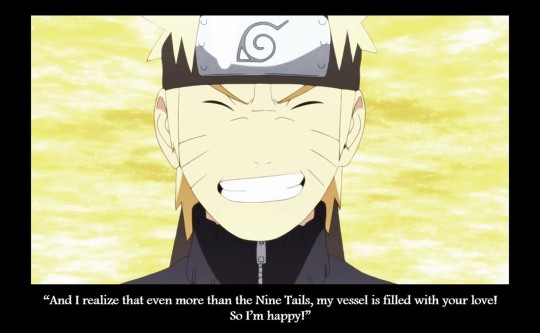
During their final moments alive, Kushina will say these words to Minato, reinstating that throughout her whole life with him, his love gave her utter joy. Naruto asks her, “So you were happy, even though you were a jinchūriki, Mom?” To which Kushina replies with a resolute “Yes,” bringing him to tears.
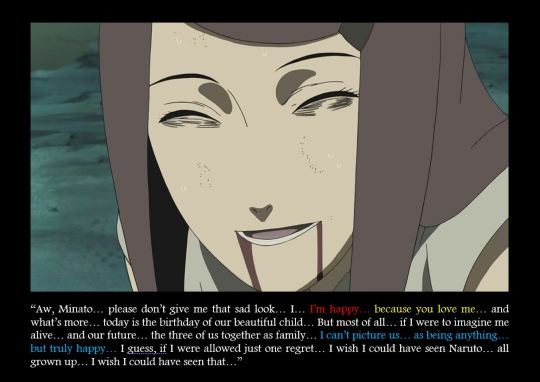
We have examined Kushina as Minato’s anchor, and Minato as Kushina’s anchor. Concluding Section A, we will look at them as each other’s anchors together.
Section A, Part III here.
#naruto#naruto shippuden#naruto gaiden#the whorl within the spiral#boruto#manga#anime#minato x kushina#minakushi#namikaze minato#minato namikaze#minato#uzumaki kushina#kushina uzumaki#kushina#kurama#uzumaki naruto#naruto uzumaki#character analysis#my deep dives
34 notes
·
View notes
Text
Minato & Kushina: A "Deep Dive" Analysis (Section A, Part I)
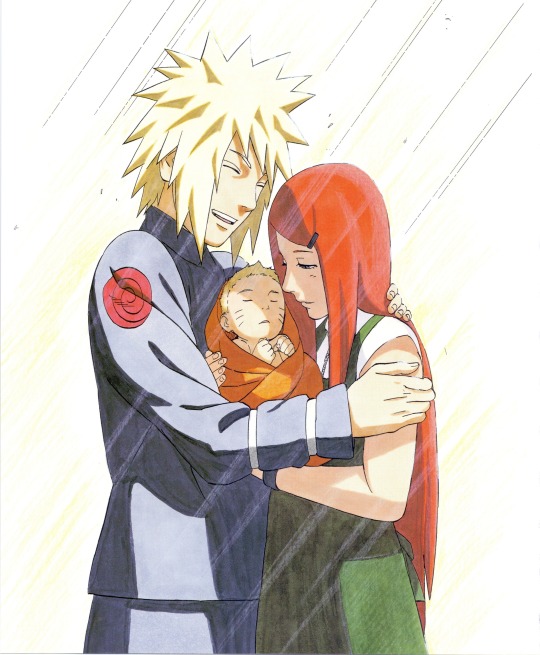
Greetings and welcome to a deep-dive into this masterpiece of a love story, where we will analyze Minato and Kushina as characters and examine their bond on the personal and plot level. We'll have five overlapping sections as follows, considering Minato and Kushina:
A. as each other’s anchors;
B. as drivers in the world narrative;
C. as cogs in the Konoha narrative;
D. as perfect compliments; and
E. as foils/parallels to other characters.
Due to the image-limit per post, I have split each section into smaller, more digestible parts. A link at the end of each part will take you to the masterlist. Now let us commence.
(Spoilers for the manga, anime and occasional spin-off. You've been warned.)
(Section A) Minato and Kushina as each other’s anchors
Let us start with some brief yet profoundly meaningful etymology. "Minato" (ミナト, 港) is the Japanese word for harbor, a safe haven for ships. "Namikaze" (波風) translates wave wind(s) – or wind wave(s) – and "Uzumaki" (渦巻き) whirlpool. Put together semantically, Minato is Kushina’s ‘harbor amid winds and waves;’ the anchorage point that keeps her from drowning in the turmoil of being Kurama’s jinchūriki.
Kushina’s strength meanwhile, as we shall see, is the reason Minato fell in love with her, and she he humbly ascribes as his pillar and constant in all spheres of life:

In this first section we will explore how these anchorages were reached. Seeing the first reveal of their bond traces all the way back to geninhood, let us start at the event pinnacle to Naruto’s question:

(A) I. Kushina as Minato's anchor
Long before he declares it in the oneshot, Naruto Gaiden: The Whorl Within the Spiral, Minato’s attraction to Kushina’s strength is inferred in metaphor. After saving her from the Cloud ninja, he says he noticed her hair right away. This manga chapter, in fact, is named after it: My Ma’s Red Hair.
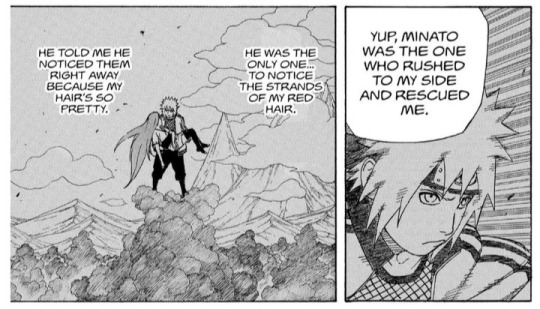
The anime’s expansion (episode: The Orange Spark) draws a subtle link between Kushina’s hair and strength – which Gaiden goes on, as we’ll shortly see, to stress as directly synonymous. The rescue infers two things about Minato’s feelings. First, his “right away” noticing of Kushina’s hair was because of its beauty. Him noticing the trail is not a singular event; he had been noticing her beautiful hair ever since they’d met at the Academy.
Second is the more subtle inference – that it was Kushina’s hair specifically which drew Minato to her. In symbolic terms, Minato was drawn to her strength:

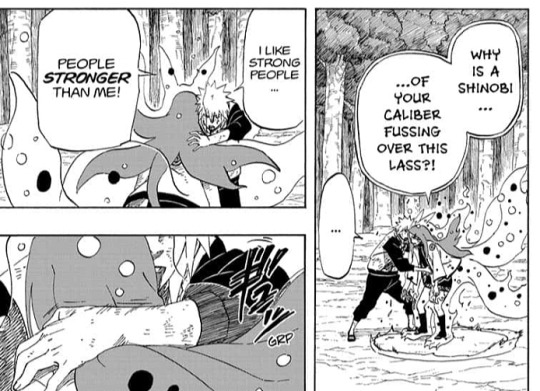
Minato’s noticing of Kushina’s strength is weaved through her recount of their childhood. We are shown it in the classroom when she catches him laughing as she takes on her bullies. We are shown it again when she spots him in the sakura tree after her scuffle with a genin. Where the rescue reveals this implicit link, however, Mito in Gaiden states the explicit. Assuring Kushina in her fears of hosting Kurama, Mito ascribes their hair to strength:
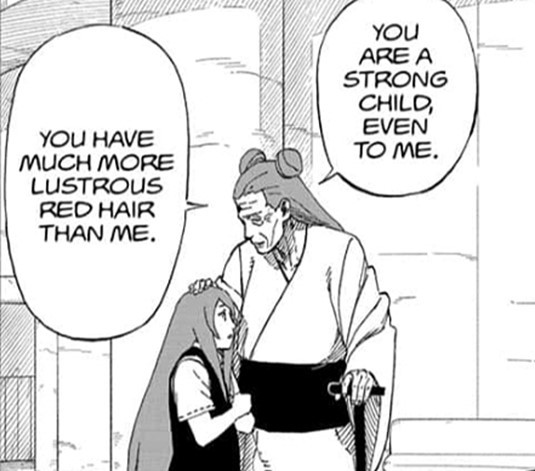
Every fullblood Uzumaki in the series (bar Ashina) has a different shade of red hair. Nagato’s is darker, like the aged Mito’s, while Karin’s is very light. Kushina’s hair, like Mito’s in her prime, is as “lustrous” as you can get – designating her “particularly powerful chakra” among the rest of her clanfolk.
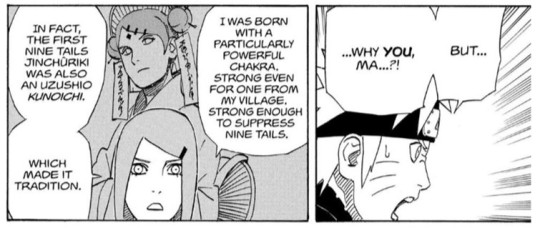
But Mito is not simply referring to Kushina’s chakra reserves. And we are shown this through the declaration of Minato’s love occuring in a paradox.
Severely wounded when Kushina’s seal breaks (her strength failing), and supporting her by augmenting it (being the strength for the both of them), Minato declares with unwavering resolve that Kushina is “stronger than [him].”
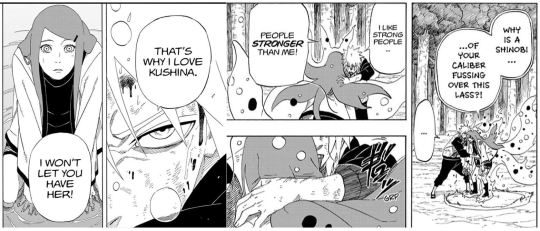
Minato believes, with every ounce of his being, in Kushina’s mental fortitude, and he will risk his life to fight for her, facing Kurama himself. It is in these lines that we find the central theme of the entire series, with both characters serving to embody it:

Kushina has, in her short life, endured a tremendous amount of suffering. She was brought to Konoha to host the most powerful and hateful of all the bijū. She was bullied by her classmates and had no friends, teased and shunned as an outsider. Her clan was massacred. Her home village was destroyed. Kurama tormented her in her sleep. She was under permanent surveillance by faceless guards, to have her every move watched in a barrier circumferencing just a corner of the village.
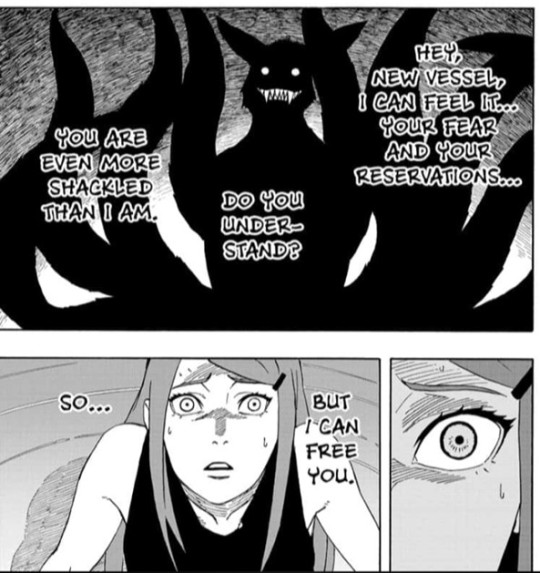
Her endurance throughout it all, first and foremost, is this “strength” that won Minato’s heart. And this strength plays a monumental – if not the center role – in him becoming Hokage. (We will focus on Hokage in Section B, but this is summed in our starting panel and the anime screen below: “Kushina… you’re the one. It was you that made me the Fourth Hokage.”) If a ninja is “one who endures,” then the Hokage is the ninja who walks in endurance before all the village. How awesome that Minato’s inspirational drive is his number one supporter and other half.
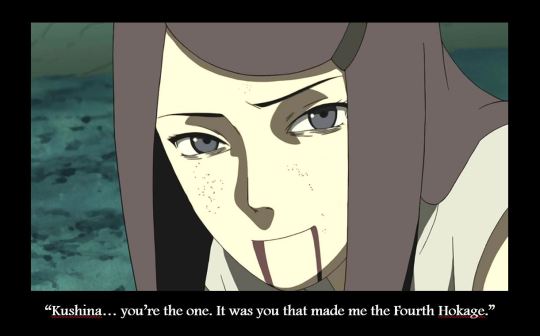
Now it baffles me how many readers/watchers miss just how strong (mentally and physically) Kushina is. So let us elaborate with the starkest display: the night Naruto is born.

She gives birth – not an ordinary birth, note (already an exhausting ordeal). But a long, agonized labor with Kurama wresting to break out of her. Then Kurama is forcibly extracted – an event which thanks to her “particularly powerful chakra” elongates her death, leaving her body in a slow, taxing battle for its draining life. Minato saves her from Kurama’s strike and she tells him to save the village, thinking of everyone else as soon as she learns their baby is safe.
The now-dying Kushina spends the short duration of Kurama’s rampage with her newborn son. She should be resting. She should be healing. She should be in her husband’s arms. Instead, with no alternative for the village’s sake, she is brought with Naruto to the battlefield.
Kushina – on death’s doorstep – pins Kurama with her Adamantine Sealing Chains, projecting a barrier to stop him escaping AND keep the villagers OUT. A jutsu that leaves her coughing up blood as she expends her fading chakra. A barrier so strong that Hiruzen, hailed the “God of Shinobi,” cannot get through it.

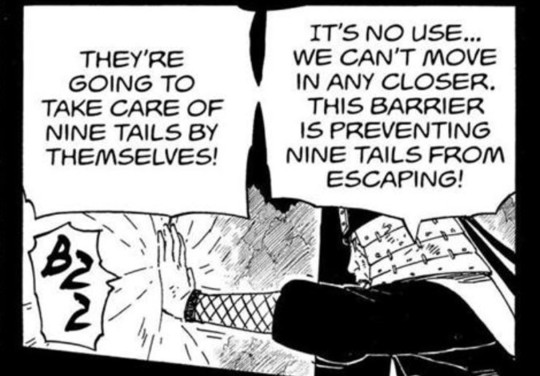
While she holds Kurama down (and Hiruzen out), she tells Minato she’ll take Kurama with her – i.e. she will reseal THE ENTIRE Nine Tails back inside herself and drag him with her into death. She has just pushed her baby into the world, had Kurama ripped from her body, and is, with her lifeforce draining away, prepared and able to seal him back.
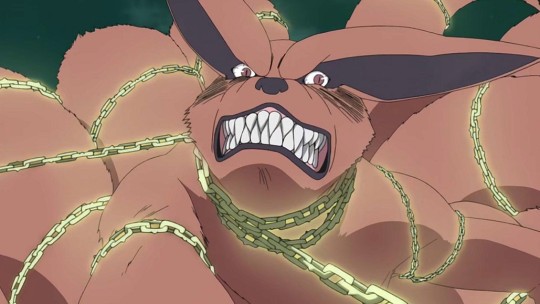
Kushina keeps Kurama pinned while under the greatest mental anguish a wife and mother could experience: her husband plans to sacrifice himself, leaving their baby an orphan, and make their baby – THEIR NEWBORN BABY – the next JINCHŪRIKI. She argues but accepts Minato’s decision even though it crushes her. Then when Kurama strikes to kill Naruto she also moves in to shield him. Kurama’s claw through her belly, Kushina still keeps him chained, buying Minato the rest of the time he needs to finish the seal.
Her nindo, lived out here, can be summed by her favorite phrase, which according to the databook is: 最後まで諦めない (“Don’t give up until the very end”).

This is the mental fortitude that Minato is talking about. And when he says “stronger than me” you can bet he means that in every definition of the phrase. (Now please don’t misunderstand: I am not at all saying Kushina could best Minato in battle. I am saying that when it comes to sheer endurance and resolve, Minato views her as his stronger half. Never does this take from the other side either – Minato being Kushina’s stronger half. As we’ll discuss particularly in Section D, they are perfect compliments.)
Kushina being Minato’s pillar carries through even after their deaths. When Minato is resurrected with Edo Tensei, he fights at Naruto’s side, facing their odds with the following inner monologue:

Later, again, as Naruto carries out his strategy, we get:

So Kushina is Minato’s inspiration, drive and rock, embodying the theme of endurance. We will return to this theme in terms of Hokageship, but let’s next look at the other side of the coin: Minato as Kushina’s 'harbor' and how his love enables her to overcome Kurama.
Section A, Part II here.
#naruto#naruto shippuden#naruto gaiden#the whorl within the spiral#boruto#manga#anime#minato x kushina#minakushi#namikaze minato#minato namikaze#minato#uzumaki kushina#kushina uzumaki#kushina#kurama#uzumaki naruto#naruto uzumaki#character analysis#my deep dives
43 notes
·
View notes
Text
Minato & Kushina: A Deep Dive Analysis (Masterlist)
If you are viewing this as a reblog, please click here for the up-to-date version

Section A: Minato and Kushina as each other's anchors
Part I - Kushina as Minato's anchor
Part II - Minato as Kushina's anchor
Part III - Minato and Kushina as unified anchors
Section B: Minato and Kushina as drivers in the world narrative
Part I - Minato and Kushina as the image of Hokageship
Part II - Minato and Kushina as types
Part III to come.
#naruto#naruto shippuden#naruto gaiden#the whorl within the spiral#boruto#manga#anime#minato x kushina#minakushi#namikaze minato#minato namikaze#minato#uzumaki kushina#kushina uzumaki#kushina#kurama#uzumaki naruto#naruto uzumaki#character analysis#my deep dives
59 notes
·
View notes
Text
Tifa's Theme: A Musical Deep Dive (Part IV)
Parts I-III here.
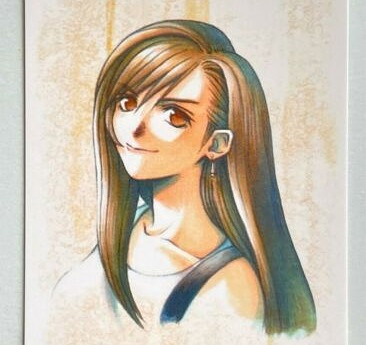
Section (D) Tifa’s Leitmotif Across the Original FFVII
(D) (I) The Leitmotif as Setup and Foreshadowing
Tifa’s leitmotif is heard just twice in the original game. The first time – in Tifa’s Theme – it loops over four crucial back-to-back story events:
Cloud and Tifa’s (first shown) reunion in Seventh Heaven;
Cloud and Barret’s argument in Seventh Heaven’s basement;
Cloud and Tifa’s recollection of their promise; and
Cloud agreeing to join Avalanche on the next bombing run.
Tifa’s Theme begins before Tifa welcomes Cloud “home;” before Marlene mistakes his arrival for her “Papa’s;” before anything at all is said about her. The music is the game’s first statement about Tifa.
As well as introducing the character and what she represents, Tifa’s Theme communicates the subtexts of the Cloud and Tifa’s bond:
The ‘reunion’ foreshadows their reunion in the Lifestream where their arcs climax;
The argument (with Barret) establishes Cloud as having no ties to any person, affiliation or cause but Tifa;
Cloud’s promise to protect Tifa is the memory tying their past throughout the narrative;
And Cloud joins Avalanche to keep their promise.
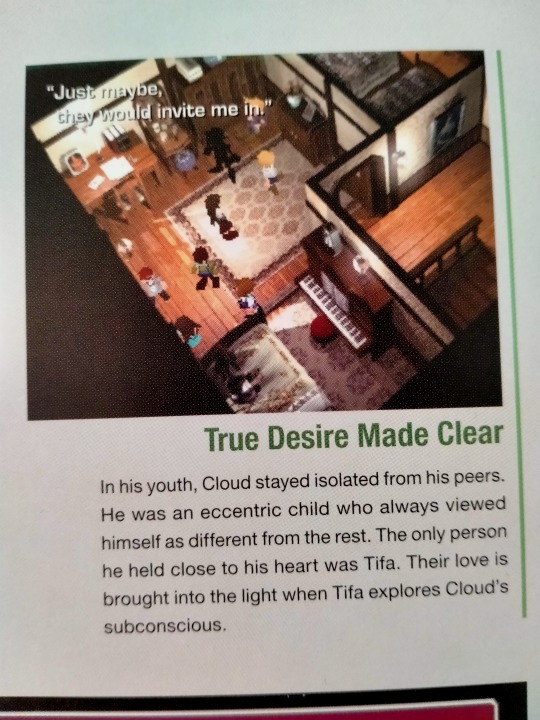
Screenshot from Cloud’s profile in Final Fantasy Ultimania Archive Vol. 2.
The second time the leitmotif is heard is in the track, The Planet’s Crisis: the conclusion of Cloud and Tifa’s arcs. Before that, however, there is a melody directly connected to the leitmotif, and that is in the high flute segment of Words Drowned by Fireworks.
(Which I will call WDBF for short.)
(D) (II) The Leitmotif as Echo and Resolution
For decades now, players have debated which Gold Saucer outing is ‘the most’ canon. That they occur as substitutes for one another and shine insight on Cloud’s canonical bond with each comrade means they are all canon. But the accompanying music track on these outings pertains to one duo very specifically. And that is in its subtle relationship to Tifa’s leitmotif. I am not talking about the instrumentation here – the flute is not unique to Tifa (it is used heavily, for instance, in Aerith and Nanaki’s leitmotifs). Nor am I referring to the track’s title – which is a homage specifically to Cloud and Tifa’s date (her words are the only words to be drowned by fireworks). No, there is a treasure here which undoubtedly gives the track away as belonging to Cloud and Tifa. And that is the pitch-for-pitch nine-note bridge to each melody’s climax (WDBF and Tifa’s Theme).
If we were to transpose one melody into the key of the other, this segment would be identical in pitch. In Tifa’s Theme this bridge is the ending of Subphrase 3. In WDBF, this bridge is the ending of the flute-passage.
Here is our segment from Tifa’s Theme in its original key of F major (untransposed):
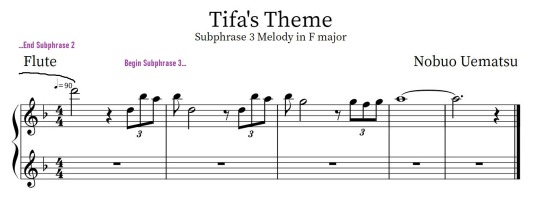
Transposed into the key of G major – the key of WDBF – we have:
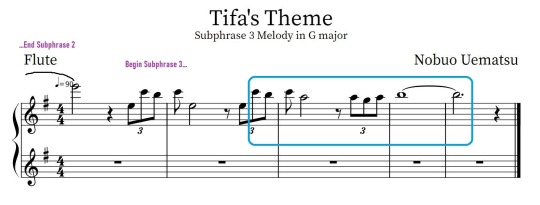
This section circled in blue is echoed in WDBF, in the exact same place where the bridge takes us into the climax.
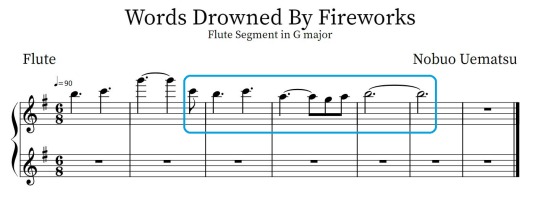
Here is our quick comparison of this section in the original keys, and transposed key (Tifa’s Theme in the key of WDBF):
youtube
The effect of this subtle echo is huge. Recall from our last post that Subphrase 3 of Tifa’s leitmotif culminates on a held A – the note she had been trying to rise to again and again since its beginning…

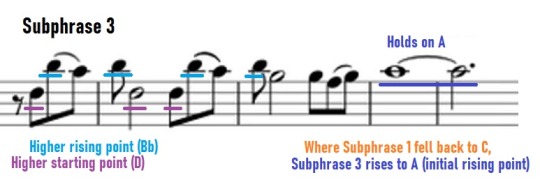
…And ending on that initial rising point, we were taken into the climax (Subphrase 4) which ultimately ended a tone below that A (our G meaning Tifa just missed the mark).
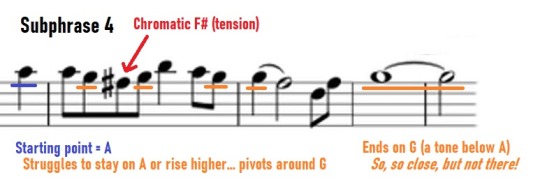
Now, with the pitch-for-pitch echo of that bridge signaling the climax-point of WDBF, we have Tifa literally, openly, trying to express her yearning love for Cloud. This note-step echo, so to speak, presents her direct, now unmistakable attempt. For while Tifa’s Theme culminates in a final struggle where Tifa locks her feelings away, WDBF bridges into the game’s main leitmotif – which is specifically, in its minor-keyed, ‘unstable’ rendition, the heart of the ‘finding-Cloud’ conflict.
WDBF does not only play at Gold Saucer. We hear it for a second time in the Temple of the Ancients when Cait Sith ‘predicts Cloud and Aerith’s future.’ Of course, by Disc 1’s end, this is revealed to be the narrative’s ruse – this conversation (metaphorically) being the drowning-out firework as Cait Sith says, “Poor Tifa.” The third and final time we encounter the track is when Tifa finds the comatose Cloud in Mideel, ending where she learns that he has mako poisoning and circumstances again keep him from her reach. This is her last ‘drowned’ expression of feelings – their next reunion (occurring with the main leitmotif in Who Am I?) being the real deal, where Tifa and Cloud together piece back their memories, recover Cloud, and Tifa learns of Cloud’s life-long devotion to her.
youtube
It has often been overlooked that Tifa has, at the point of Who Am I?’s second occurrence, lost her own semblance of self. (Forgive my error in the video – the track occurs three times and is first introduced through Cloud in the Temple of the Ancients.) I have rarely seen the subject of her own memories broached in discussion, which are, it must be emphasized, just as in need of resolution as Cloud’s. Noted in the video above, Who Am I? also applies directly to Tifa – its second occurrence being during her time in Scarlet’s gas chamber. Cloud, the anchor of her past and present, has been taken from her. Tifa doesn’t know what is real anymore, wondering whether her memories are “made up” (as she confesses later in the Lifestream). The life and home she’d rebuilt in Midgar is destroyed. And she is in a state of despair, having failed to keep Cloud safe. Tifa, simultaneous to losing Cloud, has lost herself, allegorized by her being strapped to a chair, alone in darkness, left to die under the foggy and suffocating fumes of the gas.
Moreover, this occurrence of Who Am I? bridges the two times that our brave and persevering heroine breaks down. The first, when Cloud hands over the Black Materia, where she is ready to die as North Crater crumbles. The second, on the Highwind, even after having fought for her life and escaping Scarlet’s chamber. Here, the party confronts her about Cloud and encourages her to push forward:
Nanaki: Do you think we aren’t strong enough without Cloud? Do you think we can’t save the Planet alone? Tifa: Meteor is coming, and Weapon is on the rampage… At a time like this, I don’t know what I’m supposed to do. No idea at all… Barret: Get a hold of yourself, Tifa! C’mon, let’s think about this! No way we can get offa this train we’re on! Tifa: If only Cloud was here, everything would be fine. Cloud would… stand that cocky little way he did, and tell us what to do. He’d say, ‘Everything’s under control, Tifa.’ Barret: Tifa! When’d you become such a wimp! Tifa: I’m sorry, Barret. I’m so depressed, I’m surprised at myself. Nanaki: And Tifa… the reason why we all thought it was Cloud was because… Tifa: I know. That’s why I want to make sure. That’s why I have to see him again.
Before turning to the game’s grand climax, The Planet’s Crisis, let us look at some instrumentation. The intro melody of Tifa’s Theme is played on a solo oboe, and harmonized by an electric piano and clarinet. This is interesting because, as we saw in the leitmotif and its echo in WDBF, Tifa’s voice is represented by the solo flute. Remember from Part III of our deep dive that the intro of Tifa’s Theme presented two collocating viewpoints (ours/Cloud’s, and Tifa’s) and that its ending tension (the dominant chord) took us for the first time directly into Tifa’s own viewpoint. We see the same thing happening with the instrumentation: the oboe – the flute’s neighbor relative instrument – playing the intro; and the flute then picking up her leitmotif. Flutes and oboes serve different kinds of roles all over FFVII. But in the context of Tifa’s Theme, two perspectives can be taken on the oboe:
The first, as representing both Tifa’s view and the views of everyone else for whom Tifa is ‘home.’ (The oboe presents Tifa’s view but it is clouded by her secrets, whereas the flute lifts us up into her true desires.) Because her secrets are only foreshadowed and locked away in this intro, we see the Tifa that Cloud and the party sees – we see her as home, distracted from her sufferings. Thus the two views collocate: Tifa’s and the party’s/player’s/Cloud’s.
The second, as foreshadowing Tifa and Cloud coming together – the oboe playing the climax (the game’s main leitmotif) which follows the flute (Tifa’s leitmotif echo) in WDBF, and the oboe later being Tifa’s voice (for Tifa’s full leitmotif) overlapping Cloud’s on the English horn in The Planet’s Crisis. (We’ll get to this shortly.)
While WDBF’s flute passage echoes Tifa’s Theme and climaxes with the heart and resolution of Tifa’s conflict – saving Cloud – it very, very closely resembles the instrumentation of the track Lifestream, as we’ll see in the video below. In terms of Tifa’s character arc, therefore, WDBF can be called the track that bridges Tifa’s Theme (her arc’s conflict) with the Lifestream itself (the physical setting of her arc’s resolution).
youtube
Finally, we have reached The Planet’s Crisis. Aside from WDBF’s little echo, Tifa’s leitmotif is hidden from the time of her introduction until the grand climax of the game. Why is this, from a musical-narrative standpoint? My conclusion is: to be the conveyance (together with FFVII’s main leitmotif) of the conclusion of Cloud and Tifa’s arcs. Here, at long, long last, the two leitmotifs overlap.
(D) (III) The Leitmotif as Conclusion
Cloud set off to join Soldier to gain the strength to protect Tifa, and his promise to be her hero continually drives his arc. It is during the Planet’s crisis that Cloud – free of Soldier and Sephiroth, as just Cloud – has finally carried this out. (Bear in mind the distinction between resolution and conclusion. Tifa’s arc resolved in the Lifestream with the saving of Cloud and her own sense of self. Cloud’s arc was there also resolved, with his regaining his psyche, his feelings being bared to Tifa, and his accepting of himself. The Planet’s crisis, following their night under Highwind, is the final carrying-forward of that resolution. That is to say, it is the tying up of all ends – the conclusion. Cloud who has accepted himself – his ‘weak,’ ‘failure’ self who truly was Tifa’s hero and had her heart all along – is able to save her in the very way he dreamed in the incident that kicked off their journey (Mt. Nibel).
Let us consider this narrative now together with the music.
Firstly, a note on the key. When we began our deep dive, we began with a quote by Austrian composer Ernst Pauer, who summarized F major as:
“…at once full of peace and joy, but also express[ing] effectively a light, passing regret – a mournful, but not a deeply sorrowful feeling.”
D major, the key encompassing our passage of The Planet’s Crisis, Pauer summarizes as:
“…express[ing] majesty, grandeur, pomp, and adapt[ing] itself well to triumphal processions, festival marches, and pieces in which stateliness is the prevailing feature.”
D major is popularly used in marches, carols and holiday songs. Where Tifa’s Theme carries home along with underlying suffering, its leitmotif with the main in The Planet’s Crisis carries victory.
When Cloud has caught Tifa in the crumbling crater, we hear Tifa’s leitmotif on the oboe, solo over arco strings. Below is a screen from the orchestral partition, courtesy of Courcelle Kevin here (all thanks and credit to this amazing musician and arranger whom I highly recommend looking up).
This first subphrase plays over the couple holding each other and discussing reuniting with Aerith.
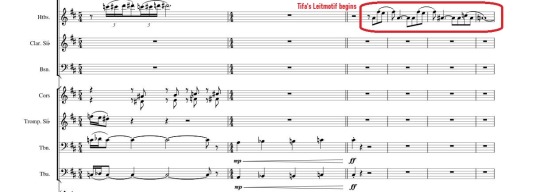
As the second subphrase ends, we have the overlap of the four-note ending of Sephiroth’s leitmotif, on the English horn (cor anglais) and trombone. This ending represents the vanquishment of Sephiroth’s influence in Tifa’s life; Cloud has at last defeated him once and for all. (Well, until Advent Children, but for our present original story…) This is conveyed in the merging of Sephiroth’s leitmotif into the main leitmotif (through the same instrumentation), representing victorious hero-Cloud. The triumphant melody overlaps with the third and fourth subphrases of Tifa’s – Tifa’s cry from WDBF being fulfilled: Cloud is found and she is safe in his arms. It is now that Cloud lifts Tifa safely onto the rock.
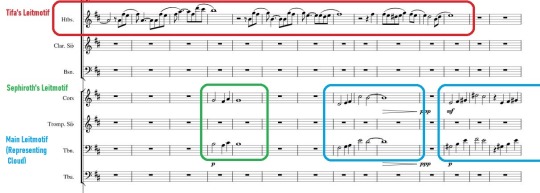
In contrast to the unstable, minor synth and strings of Who Am I?, the main leitmotif – Cloud’s voice in major – is now on sure ground. And in an almost cheeky playfulness, it starts its first subphrase, stops halfway, and then restarts a tone higher with a series of accidentals; more triumphant, more glorious, more free (image below). (Accidentals are chromatic notes foreign to the key, giving off tension against and breaking through the key’s constraints.) It is as if Cloud, stepping into hero status, begins as ‘Soldier Cloud’ would – following the pattern of his once-idol Sephiroth – only to immediately stop and go, “Hey, wait, he’s gone. It’s finished, he’s gone!” He backtracks and starts again, realizing himself different from that hero he’d dreamed of being in Sephiroth’s shadow; Tifa’s man in his own wholly free of any and all his influence.
This restart of the main leitmotif kicks off on a low E note, synchronizing with the ending high E note of Tifa’s. It is a merging of the two character voices – an effectual becoming of one. It is then that the main leitmotif takes the forefront, Tifa’s effectively being drawn up into it, as the pair turn to meet the rest of their friends.
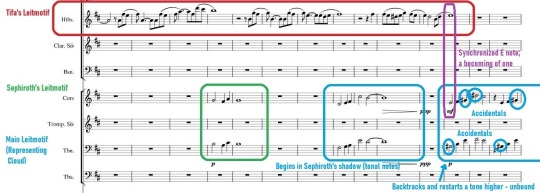
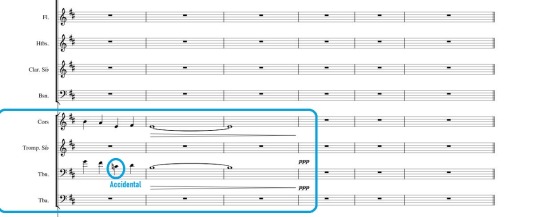
youtube
What is also interesting is the instrument combination. I mentioned earlier that the oboe is a relative neighbor of the flute. The English horn (cor anglais) is not actually a ‘horn’ – in terms of being a brass instrument (like, for instance, the French horn). The cor anglais is in fact a double-reed woodwind instrument of the oboe family. It is played in the same manner as the oboe, but differs in that it is bigger (giving it a lower pitch range), and has a rounder bottom (giving it a more reverberation). It is these two very related instruments that sync on that grand E note, in which Tifa’s voice is drawn up into Cloud’s. Meanwhile the trombone is the perfect voice for Cloud’s triumph as Tifa’s hero – no class more fitting than the brass to grandly express victory.
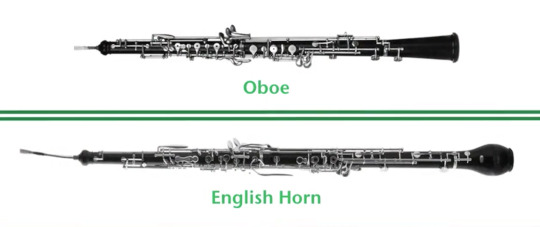
Cloud and Tifa are not the first Final Fantasy couple to have their leitmotifs overlap together. Final Fantasy VI’s ending track, Balance is Restored, introduces Celes’ leitmotif on an oboe. Then, transitioning into strings, Locke’s leitmotif simultaneously enters on… guess what? The English horn. Of course, there are many differences between Cloud & Tifa’s and Locke & Celes’ music synchrony, but I just love that little parallel.
youtube
To wrap up in summary the use of Tifa’s music in the original game (ie. Posts I-IV):
The intro of Tifa’s Theme (Post I) established Tifa as embodying home. In juxtaposing viewpoint – Tifa’s own viewpoint – were her locked-away burdens. Here we examined how the music sets up that Tifa: holds a profound motherliness toward others which outweighs thought for herself; strives to keep herself distracted from the insecurities of having to deal with her emotions; and embodies home for everyone else despite her own life being plagued by suffering.
Climaxing on the dominant chord (Post II), her conflictions were forefronted, and we were taken from the viewpoint of those to whom Tifa is home, into Tifa’s secret world of suffering. Here we saw the conveyances of Tifa being burdened by her: longings to confront Cloud with the truth; uncertainties of what the truth is; fears of losing Cloud should she take action; and doubts toward the validities of her own memories.
The leitmotif (Post III) revealed to us her drive, rock, reason, hope and the heart of her conflictions – Cloud – through its expression as: a theme of love; a clash against the always-home harmony; and a theme of perseverance.
Now that we have considered (to our efforts) the full picture, there is one final thing to point out. And that is the foreshadowing of arc closure in Tifa’s Theme itself – how Tifa’s character and journey, right down to the music, finds completion in her oneness with Cloud.
What I mean is that Tifa’s own theme track is, on its own, incomplete. Remember our observation in Post III that the leitmotif ends on and eternally loops from the dominant chord (our tension highpoint)?
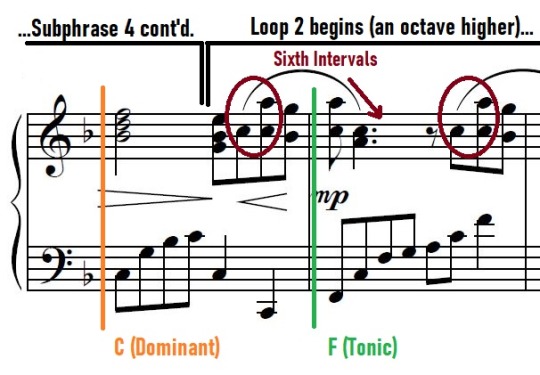
And that the final note is a held G – a tone below the A the melody was trying to reach the whole time?

Tifa’s Theme ends in the highpoint of her conflictions which, despite consistent perseverance, could not be overcome through her strength alone. This ending note – a fall-short with Tifa’s greatest efforts – at last finds resolution in The Planet’s Crisis with the synchronizing support of Cloud’s victorious lift.
Tifa’s leitmotif seeks resolution, lest it loops and loops and loops, until The Planet’s Crisis at last sees it taken up into the main. It is an ending, and it is a new beginning, of a new life together. A life where, as is vice versa, Tifa finds completion in Cloud.

That brings us to the end of the original game. But we have one more post left, where we’ll observe Tifa’s leitmotif throughout the FFVII compilation. Seeing Rebirth is just months away, I will likely post it after its release. In the meantime, thanks for journeying with me here. If you enjoyed, please follow my blog as I will be posting more deep dives on Final Fantasy VII, anime and other stories.
#final fantasy#final fantasy vii#final fantasy 7#ffvii#ff7#advent children#nobuo uematsu#tifa lockhart#cloud strife#sephiroth#avalanche#cloud x tifa#cloti#character analysis#music analysis#my deep dives
27 notes
·
View notes
Text
Tifa's Theme: A Musical Deep Dive (Part III)
Parts I and II here.
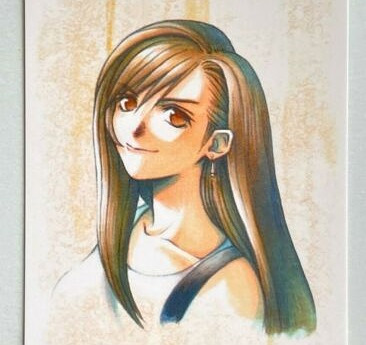
Section (C): The Main Melody (Tifa’s Leitmotif)
Alrighty. Now for fun stuff. To make things simple, we’ll first be examining the melody (the leitmotif itself) without harmony first. Here we will be using solo flute sheets an octave higher than Advent Children’s piano.

Afterward, we’ll look at melody and harmony together, and then we’ll dig a little deeper into melodic structure.
youtube
(C) (I) The Melody as a Love Theme
The melody immediately presents what we call a rising sixth interval – the focal element for conveying Tifa’s second story motif. A rising sixth interval is one of two kinds of jumps between two notes: a major rising sixth (a jump nine semitones higher); or a minor rising sixth (a jump eight semitones higher). I’ve circled the first two rising sixth intervals below – which are majors.

Along with these rising sixths, we also have falling sixths. A pattern we will see in three of the melody’s four subphrases.

Both falls are interesting. The first takes us back to our starting C note. (Recall that this C is the root note of our dominant chord – our highpoint of tension.) The second fall – following the second rise – is minor, landing on a note just above our starting C note. And this minor is extra tense, occurring on a chromatic note (foreign to the key). The remainder of this bar is chromatic, in fact – but we’ll save that for our harmonic breakdown. The takeaway point for now is that we are lifted up only to fall back to where we started, and then lifted up again to fall to a point of tension just above where we started.
Tifa’s leitmotif is built on the sixth interval. So now, let us concern ourselves with what that means. (To illustrate, I’ve circled all the rising sixths in the melody’s two loops – majors in red and minors in blue. The arrows, obviously, represent falling sixths.)
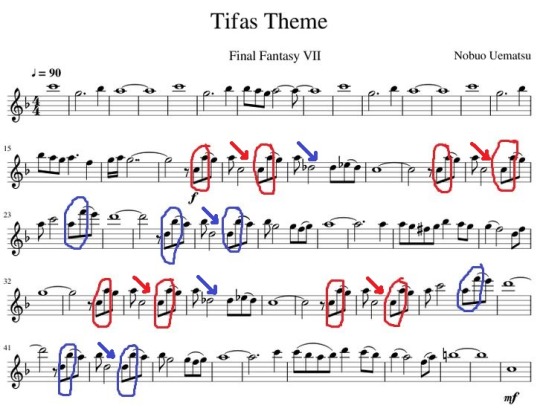
The significance of the sixth is that it is the signature interval of many memorable ‘love themes.’ It is exactly on this interval, in fact, that these love themes sound most ‘romantic.’
A major rising sixth carries yearning, pining and passion.
A minor rising sixth carries these feelings along with a sense of suffering.
Yes, Tifa’s leitmotif – our theme of home – is a theme of love. And a very, very romantic theme of love, packed with sixth intervals.

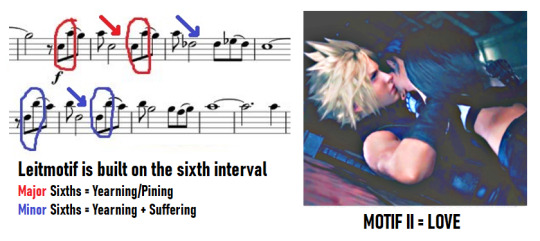
Now that we have reached the second story motif Tifa embodies, let’s consider our analysis in this new context. The intro served to simultaneously establish Tifa as home and centralize her conflictions, both of which will carry through the duration of the leitmotif. Conveyed also were two collocating viewpoints – ours (plus the characters who are with Tifa’s) and Tifa’s. We are comfortable and at peace in Tifa’s presence while Tifa herself is suffering. And she is hiding that suffering from us until we end on the tension highpoint.
It is at the climaxing clash of these tensions – in the world of our dominant chord – that we are for the first time taken directly into Tifa’s own viewpoint. Her sufferings are now laid bare; her strivings and longings, her uncertainties and fears and doubts. And we are pulled up into her strongest emotions and drive: her love for Cloud.
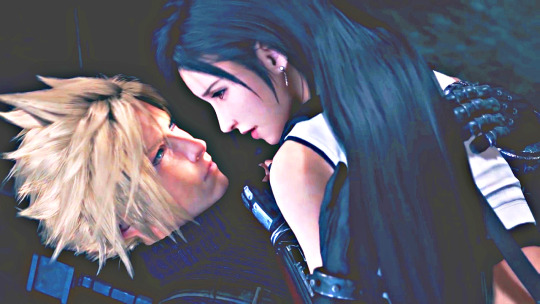
If you’re having doubts that Tifa’s leitmotif is a love theme – the love theme of Final Fantasy VII, in fact – then listen to the melodic motifs for these famous western and eastern media couples below. The romance in every one is characterized by sixth intervals, which serve as either the focal points or climaxes of the tracks.
(Some sheets are in a transposed key as I didn’t go hunting for each original.)
youtube
If you still have doubts that Tifa’s leitmotif is a love theme, then I will mention two last things. The sixth interval is the centerpiece to the love compositions of Richard Wagner and John Williams. Williams, best known for Star Wars, is the man who (most impactfully) re-revolutionized the 19th C. Wagnerian orchestra as cinema’s mainstay (Wagner being the man who popularized the leitmotif and to whom the notion of a ‘recurring love motif’ in an epic can be credited in the first place). Nobuo Uematsu, like these men, drew much influence from western classical music, his greatest influence of which he stated to be Pyotr Ilyich Tchaikovsky. An example of Tchaikovsky using striking minor sixths is in his overture of Romeo and Juliet.
Now let us analyze how exactly Tifa’s love for Cloud is conveyed.
We begin with major sixth intervals (red) and move into minor sixth intervals (blue). The harmony will show a corresponding shift from tonic chords to chromatic chords – but we’ll get to that later. My point here is that there is tension. Tension, tension, tension. And just like in our intro, we will experience constant hesitance and wavering.
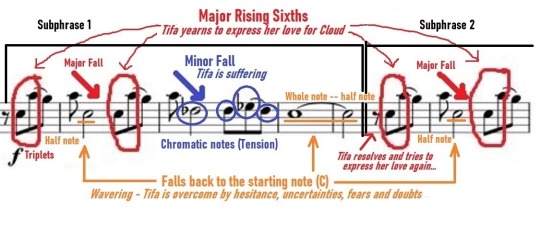
The triplet notes carry the intensity of Tifa’s longing to confess her love for Cloud (in addition to uncovering the truth around Cloud’s psyche). But every time, they are overpowered by hesitation, uncertainties, fears, and doubts – where the melody falls back down to a longer-value C (the note we began on from our tension highpoint) only for her to regather her resolve and try again. (We’ll revisit this pattern later as it also ferries our third story motif.)
This repeating melodic shape carries the painful, circular struggle:
Tifa longs to confess her love and the truth. Tifa fails; Tifa resolves.
Again. And again. And again and again.
We have now reached our transition to minor rising sixths (image below).
Four times (referring to the image above), Tifa has tried to express her thoughts and feelings. Four times she has fallen right back down to where she started. The fifth attempt (image below) is a higher, now chromatic minor sixth – a greater, more desperate resolve, with greater, longsuffering sorrow – which falls gently to held long-value notes again, emphasizing Tifa’s push with her very best efforts this time round. We follow our minor sixths through two final desperate attempts, and begin one last struggle now calmer in terms of wavering…
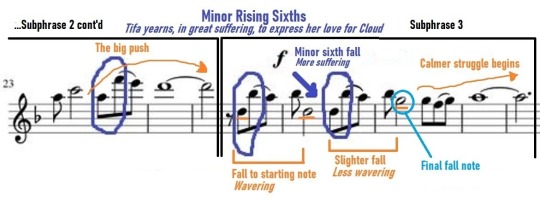
Finally, we have Subphrase 4, where we continue this less-wavering struggle begun in Subphrase 3. There are two import things here:
first, we now have no more rising sixths; and
second, our struggle now pivots around the final fall note G (highlighted blue) from Subphrase 3 above. Our sixth interval pattern ceased with this G – a consequence we’ll get to shortly…
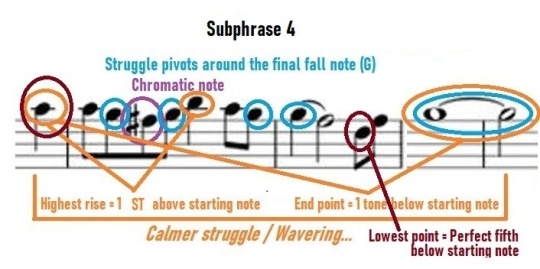
Subphrase 4’s starting note (A) is the very note we had been repeatedly trying to rise to from that tense C since the beginning of the leitmotif…

We end Subphrase 4 (and thus the phrase) on and in-pivot-around G – just one tone below that A. The meaning? Tifa is close – so, so, SO close! Yet she has just missed the mark! And so, in a new loop, we are taken right back to the beginning…
youtube
Now onto the harmony, continuing our piano sheets from Advent Children.
We are once again getting technical, so if you didn’t read the prior two posts, please do here first. (Unless you know music theory and will otherwise not be confused…)
(C) (II) The Harmony as Home
To begin, we have an identical chord progression to that of the intro. Recall our tonic-to-chromatic-to-tonic-build pattern which emphasized the motif of home:

Our leitmotif too (after beginning in tension) follows this pattern for two bars.
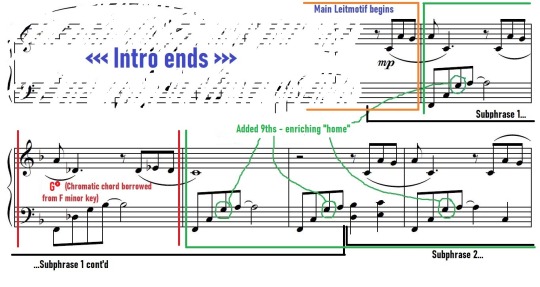
Where the melody (top stave) begins in the intro’s ending tension, the harmony (bottom stave) begins as the tonic. Immediately, albeit subtly, Uematsu-san introduces a friction between the melody and harmony. (Keep this in mind…)
Our harmony adds 9th notes to the tonic, further enriching the feeling of home and warmth. Then we have what is probably my favorite progression of the track.
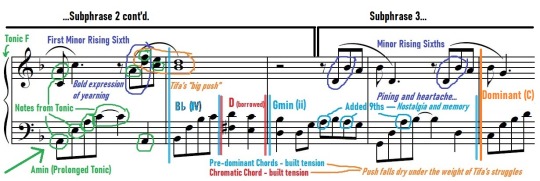
We are lifted up in a higher prolongation of the tonic (the A minor chord). In this is a rise from our major tonic chord (I) to a higher minor ‘substitute’ tonic (iii) – fusing home with the feel of desperation and elevating it. Complementing this lift from major to minor is the melody’s climb into its first minor rising sixth.
We then get a predominant chord as our ears expect. But just after our ears register it, our expectations are immediately subverted yet again. This time through a quick fall to a chromatic D major. Here we would have expected a D minor (vi) – our other tonic ‘substitute’ – which would have released tension. Instead, we are kept in the zone of tension, left to linger on the predominant G minor (ii) that follows. The result? We feel Tifa’s biggest, boldest push and we feel her stagger in the weight of her struggles.
And of course, we can’t forget those beautiful added 9ths.
Continuing our harmony (below), we find extended chord notes (7ths and 9ths) and chromatic chords. What is now striking, however, is that our tension is from here-on never resolved. We are taken from the dominant chord back to the tonic which is then prolonged. But sprinkled into this tonic and prolongation are clashing chromatic notes. Even at home, in other words, Tifa’s inner conflicts are in skirmish, and they will remain in skirmish until we are taken right back to the beginning for the second loop. Again, no matter how close she gets, Tifa’s struggles and heartaches remain.
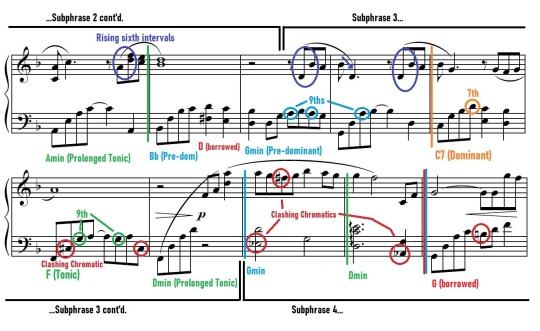
Finally, like the intro, we end on an unresolved dominant chord. And again, in this tension-zone, the leitmotif re-loops.
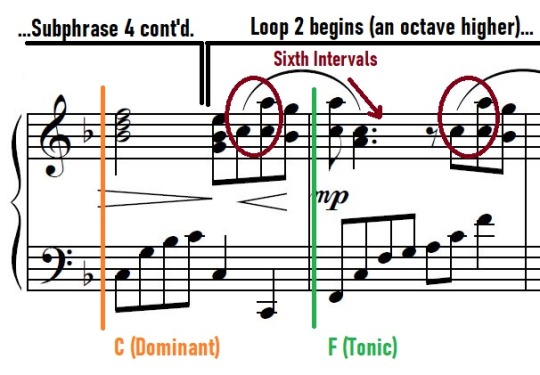
We have now covered both the melody (leitmotif) and its accompanying harmony separately. But there is one last feature to account for. That is, as I briefly noted earlier, that from their beginning the melody and harmony were in friction: the former starting in the tension-zone while the latter starts as the tonic. In short, the melody (from its beginning) is unresolved while the harmony is ‘home.’
This friction continues throughout the leitmotif’s entire run. You see, in the harmony, we are at home (via the tonic or a substitute tonic) for 9 out of 16 bars. That’s more than half of the loop. The melody, however, hardly ever touches our ‘home’ note (F). In fact, it appears to go out of its way to avoid that home note – landing it only four times.
In short, the meaning of the friction is this: Tifa is home – as in, she is home’s embodiment – but Tifa is not at home. Or more specifically, her home is somewhere else. Or, someone else…
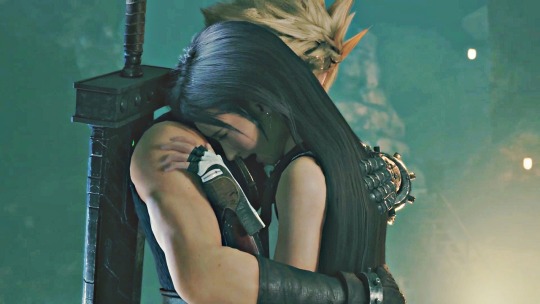
Before we go to that someone else (which will be the next post), I want to revisit the melody for one last integral trait of Tifa’s character. That is our third story motif: perseverance.
(C) (III) The Melody as Perseverance
Throughout the narrative, Tifa is brought down again and again and again. And again and again and again she gets up, refusing to give in. We’ve touched upon this in terms of the melody’s pitch structure already (the circular rise-fall struggle with those sixth intervals), but let’s analyze in a little more detail just how it seethes perseverance specifically.
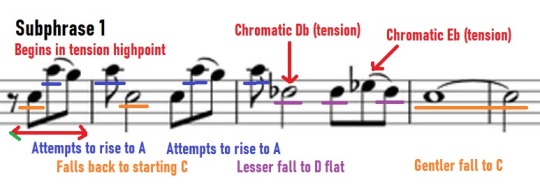
Our second fall lands on a chromatic D flat – a mere semitone (the closest possible note) above C. In other words, Tifa, in this first grapple, manages the tiniest step up. The chromaticism conveys that staying on that D flat and pushing above is an immense struggle – a struggle which Tifa loses, overwhelmed under the chromatic E flat, an unforeseen obstacle that knocks her back down.
In three attempts already she has attempted to rise to A, reached A but struggled to stay there, and ultimately fallen back down to the C where she started. And so, Subphrase 1 ends.
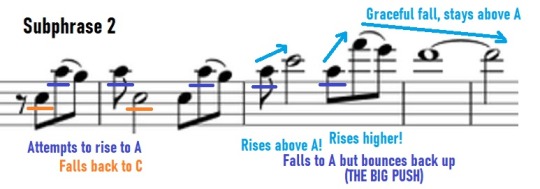
Starting back on C, Tifa perseveres again, this time, after another fall, to rise above A. And here something profound happens: A momentarily becomes Tifa’s new starting point, and it is from A that she gives her biggest push ending on a graceful fall that remains above. This occurs over the predominant G minor chord however, meaning that Tifa is in the midst of a tension zone (moving toward the dominant) where her victory is short-lived. Recall also that we have now shifted from major rising sixths to minor rising sixths, amplifying her own sorrows and frustrations. Here ends Subphrase 2 and begins Subphrase 3.
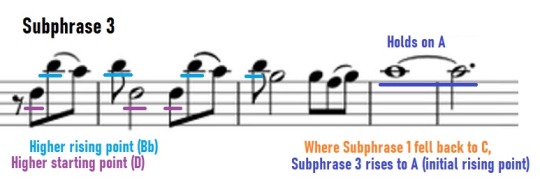
Subphrase 3’s struggle begins a tone above Subphrase 1 (D above C), and its rising point (B flat) is a semitone above A. Tifa, catching herself in her latest knockdown, pushes on, stronger. And she now carries with her – conveyed through the minor sixths – greater forefronted sufferings. She falls down again from the new rising point (B flat), but she manages to, rather than falling back to her starting D, lift herself back up to A, where she perseveres into the next struggle-point.
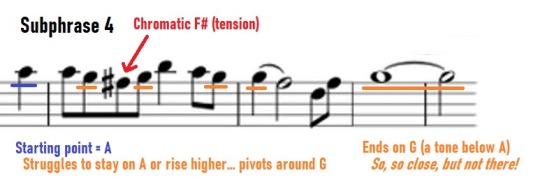
Here Tifa seems to have reached her limits, her greatest efforts teetering around and ending a tone below A (that G we examined earlier).
Ultimately, Tifa, despite all her perseverance, cannot overcome her inner conflicts in her own strength. Which brings us once again to Cloud… to be continued in Part IV.
This video is a repeat of the last one, but I encourage a listen to the way Tifa’s love and perseverance overlap:
youtube
We are now ready to examine Tifa’s leitmotif across the FFVII story. Part IV will be on the original game, and then, in due time, Part V will be on the compilation.
Part IV here.
#final fantasy#final fantasy vii#final fantasy 7#ffvii#ff7#advent children#nobuo uematsu#tifa lockhart#cloud strife#cloud x tifa#cloti#avalanche#character analysis#music analysis#my deep dives
21 notes
·
View notes
Text
Tifa's Theme: A Musical Deep Dive (Part II)
Part I here.
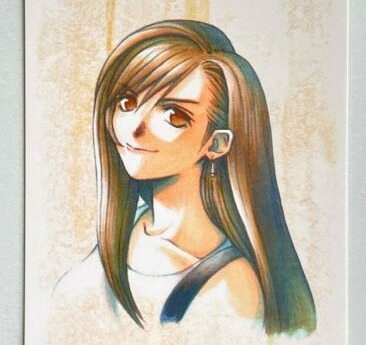
Section (B) continued:
Concluding our second subphrase of the intro, we now encounter the dominant chord.

Now to those of you new to music theory, I must introduce the idea of chord function. (If you are not a rookie on chord function, then skip to the text three video-clips ahead.) Don’t worry, we will keep things brief and (hopefully) as simple as possible!
You may have noticed when we compared our F major key to D minor (from Listen to the Cries of the Planet) that there is a scale of seven chords in each key. Each of these seven chords serves a particular function within the key, and that function pertains to the relationship between the tonic and dominant chord.
We’ve already noted that our tonic is our ‘home’ point; our point of return, resolution. The dominant is the chord farthest from the tonic in pitch; the place of the highest tension. It is the goal of every musical score to constantly move away from the tonic and return to the tonic, and it is these mini-journeys that subvert, intensify and carry emotion.
Here are the seven chords within our key of F major, labeled in roman numerals by their scale degree (majors in capital, minors in lower-case). Don’t be overwhelmed – there’s no need at all to memorize them! I am just using them to illustrate the rules.
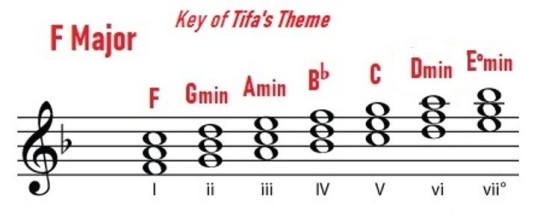
You’ll notice that our tonic (the F major chord) is named by the roman numeral I. Because chords iii and vi share two notes of the tonic, they share resemblance to the tonic in pitch and therefore function either to ‘prolong’ the tonic or serve as ‘substitutes for’ the tonic. The other chords, however, move away from the tonic in pitch (creating tension), until we get to our dominant – chord V. Because chords ii and IV share notes with the dominant, they are called predominant chords. Chord vii° is a bit special: it can stand in for any function except the tonic.
So in summary, each chord in the key functions as either:
the tonic;
a ‘prolonged’/’substitute’ tonic;
a predominant; or
the dominant.
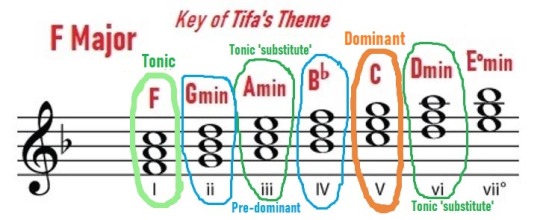
Music rookies, are we in Greek territory now? Don’t panic – the sole point I want you to take away is this:
The dominant maximizes instability that will be resolved by the tonic; thus
if a musical phrase does not end on the tonic, it feels ‘unsettled’; and so
for the music to find resolution, it must return to the tonic.
The dominant climaxes tension; the tonic provides release of tension. And so we go, round and round and round, having our emotions toyed with.
To demonstrate the four functions, I’ve provided a simple chord progression in our F major key. Don’t worry about the labels so much as listening to the building and releasing of tension. (All I am doing is highlighting what our ears naturally pick up.) Tension and release, okay? That is all we are looking at. This excerpt is from Yasuharu Takanashi’s track ‘A Mother’s Love’ in Naruto Shippuden:
youtube
See how our phrase ends on the dominant and feels unsettled? Our ears are naturally left seeking resolution: we expect to come home to the tonic. Here is the piece again and continued, where that tension is released…
youtube
Tifa’s Theme is a lot more complex. Recall our chromaticism so far (chords ‘borrowed’ from the parallel minor key) – which, as we’ve already established, create tension also. I have only scratched the surface when it comes to chromaticism in Tifa’s Theme, but that is not our focus for today. Again, I just want you to listen for tension and release. Here is the original game’s intro as re-orchestrated in Remake. (Remember, don’t worry about the labels. Just focus on what you are naturally hearing.)
youtube
Right. Picking back up on our analysis. As you’ve now seen in A Mother’s Love (by the way, see the key’s beautiful connection with home and motherhood?), F major’s dominant (chord V) is C major. Did you notice that the intro passage of Tifa’s Theme, however, ends on a C minor chord? We will get to this chromaticism shortly. But let us resume where we left off first: the last two bars in Subphrase Two.
Where Subphrase One ended nice and neatly on our tonic…

…Subphrase Two does the polar opposite. A predominant chord follows our tonic (building tension) prior to the last bar. Then, where we expect resolution, we end on the dominant – our highest tension key-chord. And in fact, it is in the midst of this very tension that the main melody kicks off…

Here is our summarized analysis of Subphrases 1 and 2 (the whole Advent Children intro):
youtube
Advent Children’s intro has only one phrase (comprised of the two subphrases we just dissected). But the intro in the original game’s version of the track, as you’ll have noticed from our re-orchestrated video, has two. Its first phrase (Subphrases 1 and 2) ends resolved on the tonic chord. The second phrase (Subphrases 3 and 4), however, ends – like Advent Children – in tension. I have contrasted these two phrase-endings in the video below.
Rather than the E note of the first phrase (C, E and G being the notes of the C major dominant chord), the second phrase’s last chord contains an E flat, making the chord a C minor rather than a C major. C minor is not the dominant we’d find in our F major key, but rather the dominant of F minor. So once again, Uematsu-san has ‘borrowed’ from the parallel minor key. Only this time he has borrowed its tensest chord, creating even greater instability. And here exactly ends our intro as Tifa’s main leitmotif begins.
youtube
So what does this unresolved, unstable ending convey? The fully-established permeance of Tifa’s internal conflict. With the intro ending in utter tension, and the main leitmotif jumping in amid this tension, Tifa’s conflictions are wholly and completely centralized.
Below is our full analyzed piano sheet of the intro, with the orange ‘waverings’ representing Tifa’s:
strivings to avoid being trapped with her anxieties and heartaches;
longings to confront Cloud with the truth;
uncertainties of what the truth is;
fears of losing Cloud should she take action; and
doubts toward the validities of her own memories.
In a nutshell, her internal conflict. Which also pertains to her connections with Avalanche, in that she:
is Avalanche’s home and maternal figure;
feels “trapped” in her position with Avalanche’s fight despite her desire for revenge against Shinra;
is morally hesitant about Avalanche’s methods;
is uncertain about her feelings and role within Avalanche; and
fears losing all her loved ones and community to Shinra – again.
And that concludes the intro. Here is our full summary:
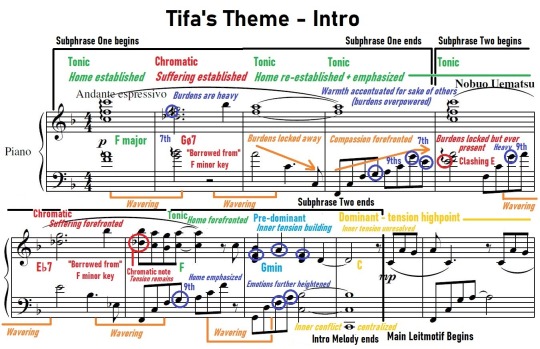
Part III, the main leitmotif, here.
#final fantasy#final fantasy vii#final fantasy 7#ffvii#ff7#advent children#nobuo uematsu#tifa lockhart#cloud strife#avalanche#cloud x tifa#cloti#character analysis#music analysis#my deep dives
17 notes
·
View notes
Text
Tifa's Theme: A Musical Deep Dive (Part I)
(A repost from my old side blog no longer in use. All future analyses will be on this one.)

Greetings and welcome to a deep-dive into Uematsu-senpai’s masterpiece of a character theme. We will examine the rich marriage between composition and storytelling – i.e. how its musical elements express Tifa’s personality, conflictions, relationships, and story motifs. If you’ve come with zero knowledge in music theory, then my hopes are that you will leave here somewhat enriched (no prior knowledge is required). If you are a fellow geek for music, then I hope this adds insight in a storytelling sense. Ultimately, the goal of this post is to more deeply understand Tifa Lockhart.

I have divided this analysis into five sections each built on the prior: (A) the key; (B) the intro; (C) the leitmotif; (D) the original game’s use of the leitmotif; and (E) the compilation’s use of the intro and leitmotif. (The leitmotif of course being Tifa’s recurring melody, of which the first subphrase is sampled above.) Because Tumblr allows only 5 videos per post, some sections are spread across two posts.
So have your headphones/audio ready, and let us commence.
Disclaimer: these are simply my own interpretations offered with supporting evidences. I can only, to my best limited efforts, speculate as to what Uematsu did or did not intend when composing the piece.
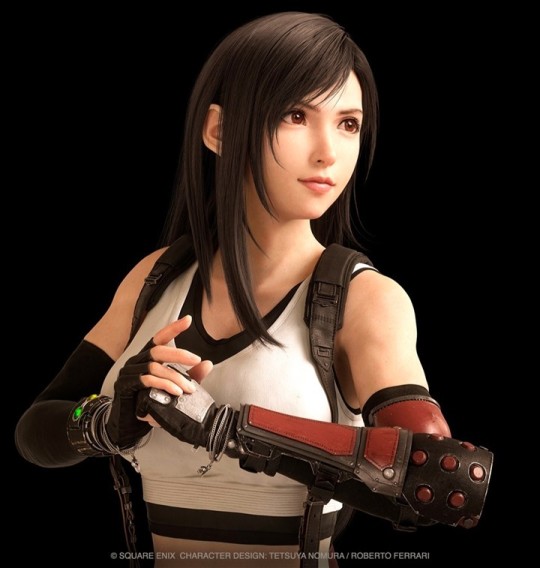
Section (A): The Key
Tifa’s Theme is composed in the key of F major, one of the happiest keys in music. It is argued by many, in fact, to be the happiest key (though this is subjective).
“F major is at once full of peace and joy…” – Ernst Pauer (19th C. composer).
This is a reason, I presume, that Uematsu-san chose F major for the track which represents home.
“Welcome home, Cloud,” is the first line that Tifa speaks to Cloud in the game. “I’m home” (from the Japanese dub, 唯今 – “Tadaima”) is the last thing Cloud says to Tifa at the end of Advent Children. Home is our first story motif embodied by Tifa’s character.
But of course Uematsu’s decision likely only began there.
“F major is at once full of peace and joy, but also expresses effectively a light, passing regret – a mournful, but not a deeply sorrowful feeling.” – Ernst Pauer (quote continued).
So we have peace and joy with an undertone of mournfulness; a juxtaposition between two opposing ends of the emotion spectrum. To appreciate how the key of F major achieves this, we can benefit from a quick comparison with two other tracks.
It might surprise you that Tifa’s Theme – our warm song of home – shares the very same key notes as the tensest and most sorrowful track in Final Fantasy VII. Listen to the Cries of the Planet is composed in F major’s relative minor key: D minor. It has the same key chords as F major, yet the chords serve different functions (something we will get to later). Put another way, it has all the same notes, yet they are arranged differently. Where F major is (argued) the happiest key in music, D minor is almost universally called the key of “true sorrow.”
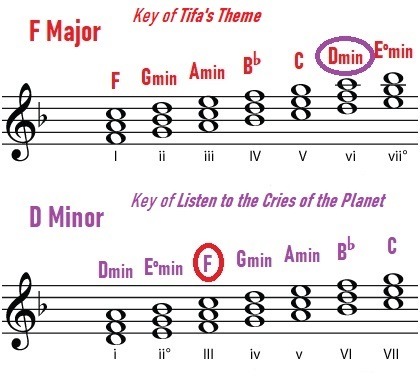
Let’s compare the two tracks here:
youtube
I wanted to begin with this little contrast for three reasons. First, to excite you non-music-theorists about the emotive power of music. Here, from our two related keys, come two completely contrasting moods. Second, we are concerned with what and how the notes will speak. Third, well… that’s a little more selfish. Listen to the Cries of the Planet is one of my favorite tracks in the game.
Our other track is One-Winged Angel – the main passage, for there are three keys in this track. It is curious that the foil villain to Tifa has his fighting theme in the relative minor of hers. Like a mirror – for as Sephiroth is Cloud’s despair, Tifa is Cloud’s home. Or, to borrow a Kingdom Hearts metaphor, we’ve Cloud’s darkness against Cloud’s light. D minor is also the key of Sephiroth’s main theme: Those Chosen by the Planet.
youtube
And now, onto our deep-dive into Tifa’s Theme, which features in the original game, Advent Children, and 2020’s Remake. For now we’ll be using the piano sheets from Advent Children.
Section (B): The Intro
youtube
Tifa’s Theme begins with a tonic chord (the ‘home’ chord of our key). The further we move away from our tonic, the greater the tension (instability) will be.
By ‘home’ here I am referring to the music’s tonal center – not ‘home’ the story motif which Tifa embodies. In light of that distinction, however, with the tonic being the home point of the track and home being a story motif central to Tifa’s character, we are simultaneously referring to both.
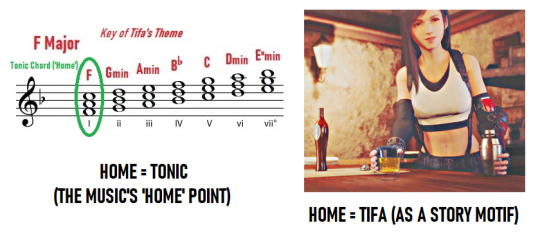
So we begin with our tonic (the F major chord) which draws us “at once [into] peace and joy.” Yet there is concurrently the hint of a mournful undertone. Only a tiny, tiny allusion – perfect for our introduction to Tifa. When we first meet her after all, we’ve no idea of the burdens locked in her heart.
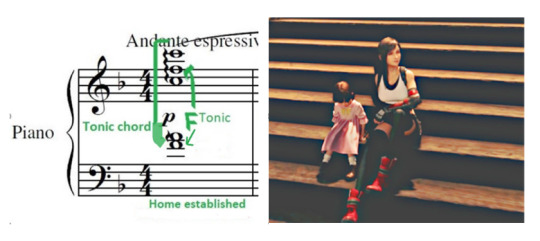
This opening tonic is presented in whole notes (the longest kind of note in common composition). In our piano version, these whole notes are arpeggiated (see the squiggly lines to their left), meaning that the chord is ‘spread’ or ‘rolled’ – the notes are played and held one after the other from the bottom up. We are at once drawn in by Tifa’s inviting warmth and we linger there.
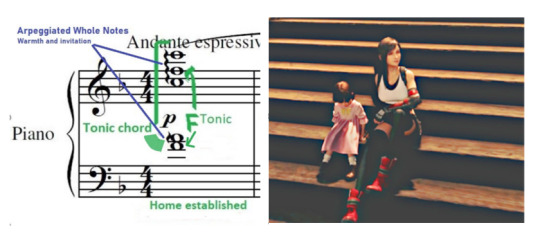
Our tonic is immediately succeeded by a chromatic chord (a chord composited of notes outside the key; notes that ‘don’t belong’). This second chord, in fact, is the sort we would expect to find in F minor. It does not ‘belong’ in our key of F major – thus the mournful undertone which would have been further hinted is brought into direct statement. Foreshadowed is the revelation of Tifa’s burdens. She is carrying deep and unsettling secrets.
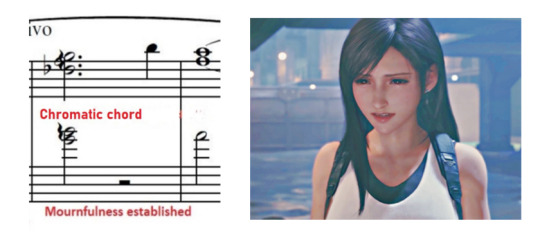
How does this work? Uematsu-san has effectively ‘borrowed’ the second chord of the F minor key and inserted it into the track’s opening chord progression. This subverts the natural expectation of our ears and creates instability – a trick he will frequently pull to toy with our emotions.
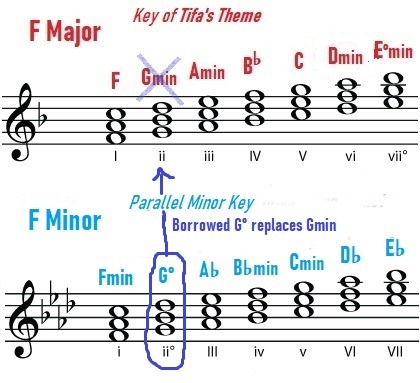
Uematsu-san then extended this borrowed chord to heighten the mournfulness by adding a 7th (a note seven intervals above the root note which further colors the mood). This enlarges the magnitude of Tifa’s mournfulness: we feel that her burdens are heavy.
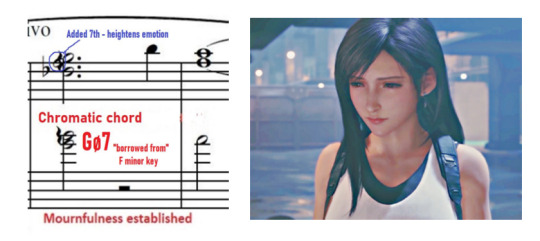
The next two bars instantly carry us back to the tonic (see the harmony on the bottom stave below). This occurs in a slow fall, a faster fall, then a faster, now extended lift: the intro’s re-establishment and emphasis on the motif of home. We are never to stray from feeling at home when we are around Tifa. Simultaneously, these bars speak the ‘locking away’ of Tifa’s burdens. Her sufferings are buried quickly as her love for others is brought to the forefront.
Where our chromatic chord had an added 7th to heighten the mournfulness, our tonic build is extended with a 7th and 9ths in its lift – heightening home in a stronger comparative sense. Tifa being a home to others, in other words, overpowers her own sufferings.

There are three things we can grasp from this sequence of slow-fall to faster-fall to faster-extended-lift.
First, Tifa holds a profound motherliness toward others which outweighs thought for her own wellbeing.
Second, Tifa is insecure in dealing with her emotions, and thus strives to keep herself distracted from them. We will see this displayed right from the time of her childhood:
At 8, unable to cope with her mother’s death, she treks up the perilous mountain to try and ‘find her’ on the other side;
At 15, unwilling to face the grief of her father’s murder, she recklessly rushes to confront Sephiroth;
At 17 (in Traces of Two Pasts), she confesses to Jessie that she has been “running” from learning the truth about Nibelheim;
At 20 (in Remake), she admits she’s not even allowed herself time to decorate her apartment;
At 22 (in On the Way to a Smile), she avoids being alone in keeping extra busy with the bar and the kids during Cloud’s absence.
Thirdly – and perhaps most jarringly – Tifa embodies home despite her life being plagued by suffering.
Tifa, who lost her home and had to rebuild her life from scratch, provides a home for Cloud, Marlene, Barret, Avalanche, and later, Denzel.
Tifa, who lost her mother as a child, mothers everyone else, is for all intent Marlene’s mother, and becomes the mother of a family unit with Cloud.
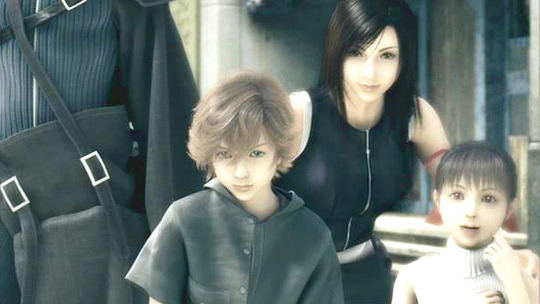
We have now travelled through the first subphrase of the intro.

youtube
We begin Subphrase Two with our opening tonic again, but this time in a quite surprising extension. Rather than adding a happy 7th or 9th to accentuate the warmth of our home chord, Uematsu-san gives us an E note which clashes with our F. Moreover, he builds the chord from this E as the bass (bottom) note.
What does this mean? Dissonance. Home is re-emphasized, but now directly with mournfulness. Although Tifa’s burdens are locked in her heart, they are ever lingering in the picture.
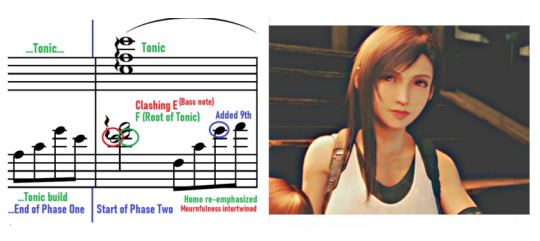
Compare this tonic (with the clashing E) to our opening tonic in Subphrase One. We now also have an additional climb in the harmony, which includes an added 9th. So while we can more deeply sense Tifa’s mysterious burdens (even though she’s our place of peace), extra emphasis is placed on her warmth and motherliness.
Subphrase One opening vs. Subphrase Two opening:
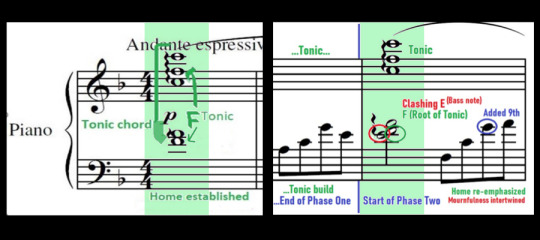
And so we continue Subphrase Two, following the pattern from Subphrase One. A chromatic chord follows the tonic – again ‘borrowed’ from the key of F minor – bringing Tifa’s plights to bubble once again. But before we can linger on them, we are taken back to an extended tonic chord – this time with an ‘unbelonging’ note.
From the next bar, however, things begin to shift…

Before moving onto this shift, let’s consider what we’ve covered so far. We began “at once full of peace and joy” (Tifa’s warmth pulled us toward her, pulled us home), to be immediately carried into an expression of suffering (Tifa’s secret, unsettling burdens were glimpsed). That suffering was overpowered – but not entirely suppressed – by a magnified emphasis of home (Tifa locked her burdens away behind her nurturing kindness). The suffering surfaced briefly again, and again home was accentuated (Tifa’s endless heartache continues beneath the bounds of her love).
As is very clear by now, Tifa is facing great internal conflictions. Let us dig into what the music so far has conveyed of those conflictions.
Spoken in long-value notes, our Subphrase One melodic chords convey: our peace when we are with Tifa; and Tifa’s hesitance in expressing her burdens. That they shift and waver between tonic and chromatic conveys her uncertainty.
Subphrase One conveying hesitance (in long-value notes):

Subphrase One conveying uncertainty (tonic > chromatic > tonic):

Tifa is longing to confront Cloud with the truth of his psyche. At the same time, she is uncertain of both what that will bring and what the truth is: she fears losing Cloud; and she doubts the validity of her own memories from the events he is recounting so accurately. These hesitancies, fears and doubts are gnawing at her heart, buried from the rest of the world under the forefront of home.
Subphrase Two contains less long-value notes and more wavering than Subphrase One, building the intensity of Tifa’s conflicts clashing within her. Rather than wavering from tonic to chromatic to tonic, we go from a dissonant tonic to a chromatic chord to a tonic with chromaticism to more tension in a predominant chord. I’ll get to what this means in the next post, but for now, just know it is a chord of tension.
Subphrase Two (less the final bar) building instability:

Following our new tension chord (the predominant G minor in blue) we have just one bar left to end the phrase. As it is the end of the intro as a whole, we expect to return to the tonic. But (bless Uematsu and his subversions)… the opposite happens.
Our ears expect resolution, but we are instead dragged right into the highest point of tension. Here, we are pulled into the world of the dominant chord.
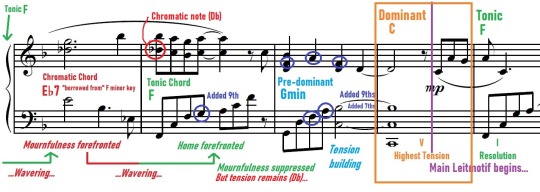
Continued in Part II here.
#final fantasy#final fantasy vii#final fantasy 7#ffvii#ff7#advent children#nobuo uematsu#tifa lockhart#cloud strife#sephiroth#avalanche#cloud x tifa#cloti#music analysis#character analysis#my deep dives
30 notes
·
View notes
Text
Tifa's Theme: A Musical Deep Dive (Masterlist)
If you are viewing this as a reblog, please click here for the up-do-date version.
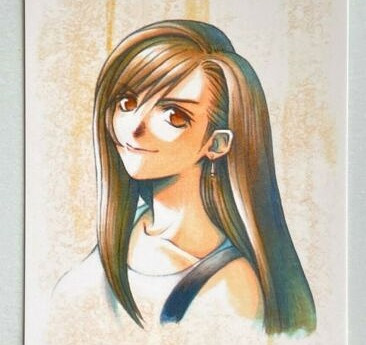
Part I Part II Part III Part IV Part V to come
#final fantasy#final fantasy vii#final fantasy 7#ffvii#ff7#advent children#nobuo uematsu#tifa lockhart#cloud strife#sephiroth#avalanche#cloud x tifa#cloti#character analysis#music analysis#my deep dives
17 notes
·
View notes
Text
Deep Dive Masterlist
If you are viewing this as a reblog, please click here for the up-to-date version.
Deep Dive Analyses:
Final Fantasy VII: Tifa's Theme
Naruto: Minato and Kushina
2 notes
·
View notes